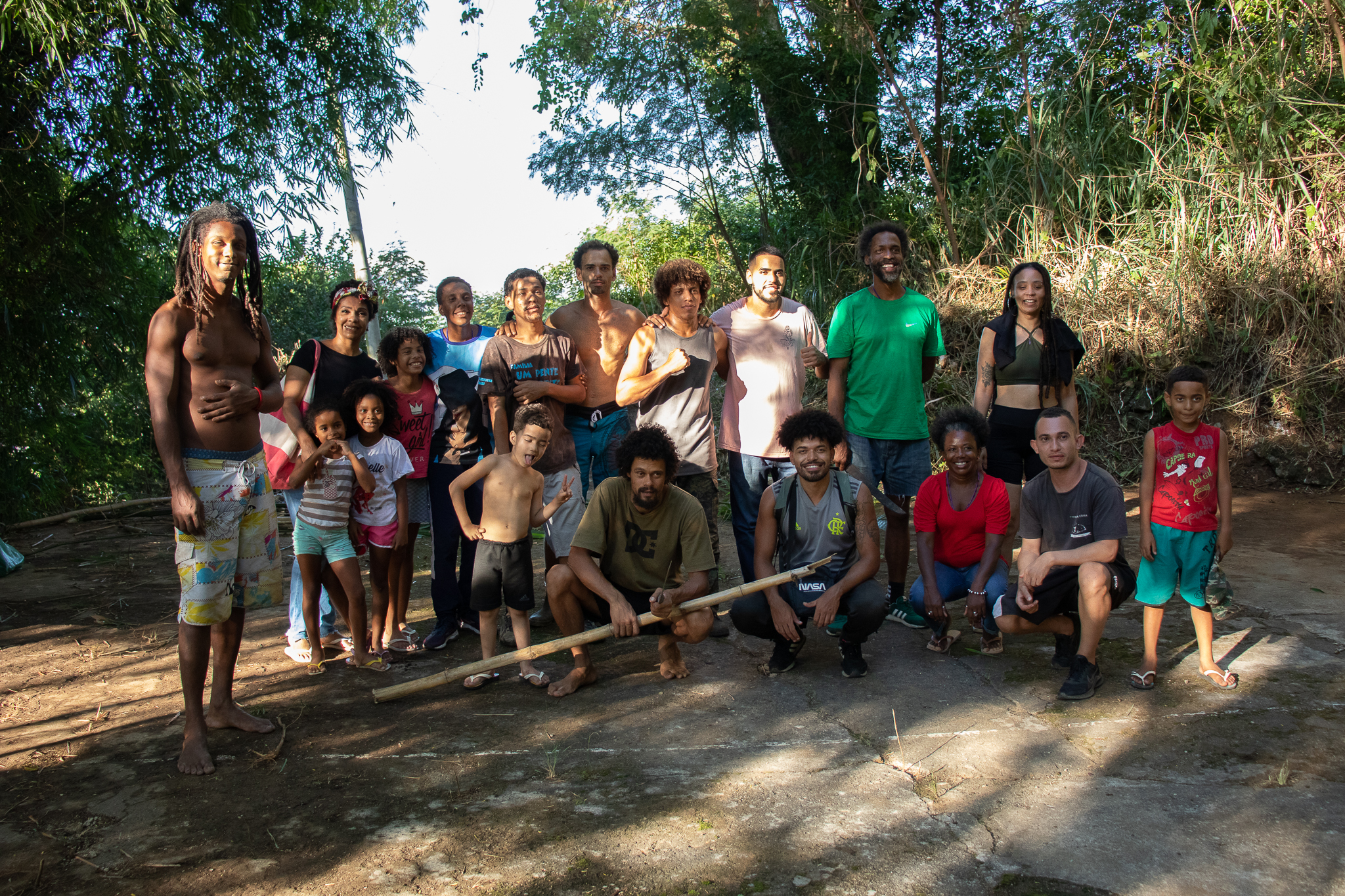Clique aqui para Português
Concerned by the neglect facing Pedacinho do Céu, or “Little Piece of Heaven”, as the area atop the Rio de Janeiro favela Morro do Turano is known, current and former residents revitalized the area where the North Zone community was established nearly 90 years ago.
For some time now, we have been hearing about climate change, its causes and consequences, and the importance of preserving the environment, issues concerning environmentalists and authorities the world over. In Brazil, another concern is environmental racism, since the people most affected by climate change are those living in favelas and peripheral areas. They are faced with landslides, the overflow of polluted and silted rivers during heavy rains, and the lack of proper waste collection by the State. Garbage clogs manholes and ditches, pollutes rivers, streams and springs, causing flooding during the rainy season.
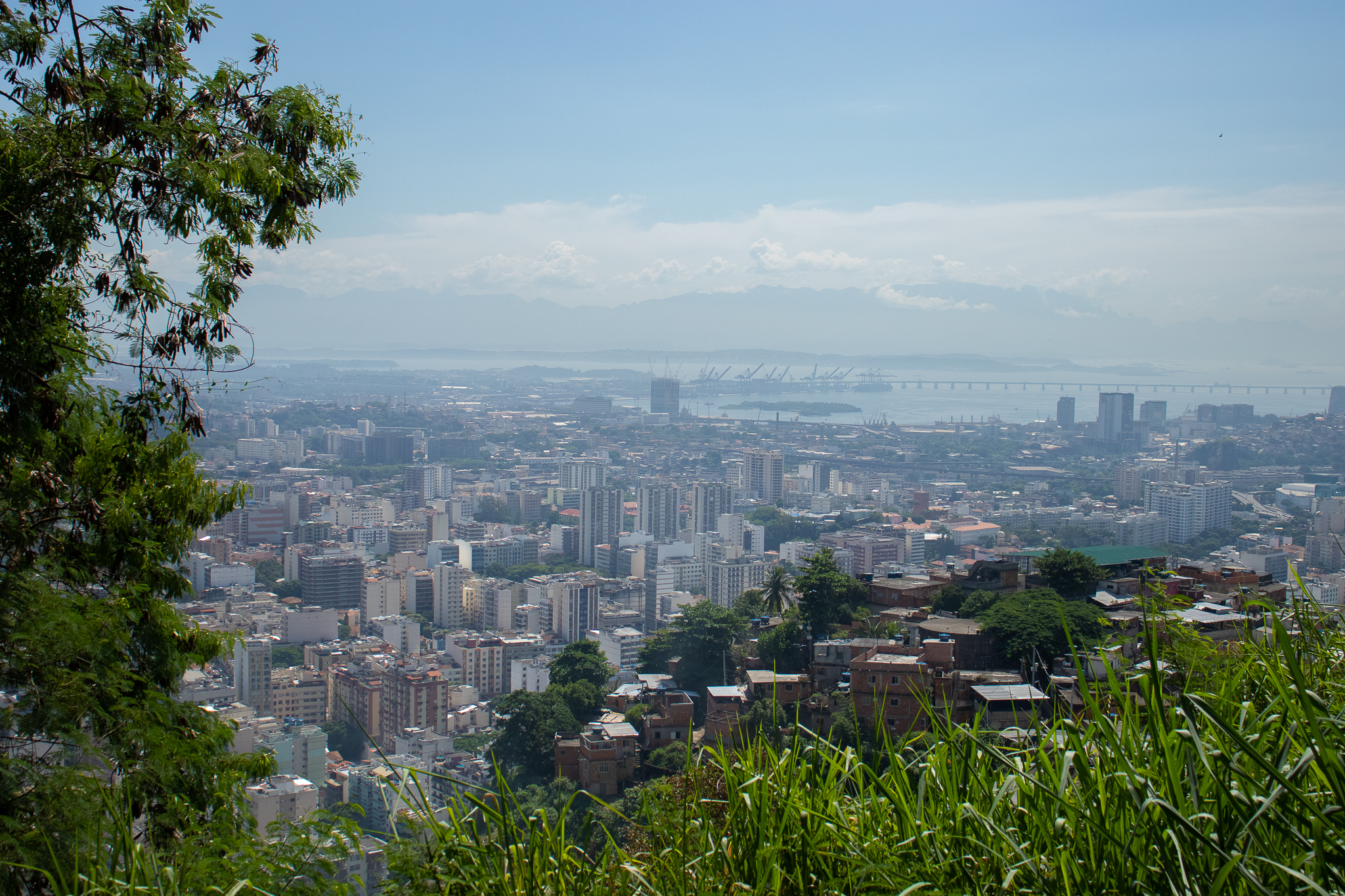
In the city of Rio de Janeiro, between the high-end North Zone neighborhoods of Tijuca and Rio Comprido, one of the areas that suffers from changes to climate and the impacts of heavy rainfall is Pedacinho do Céu, in the top part of Morro do Turano. Residents have been concerned with landslides and falling rocks for some time, and complain about government neglect and abandonment.
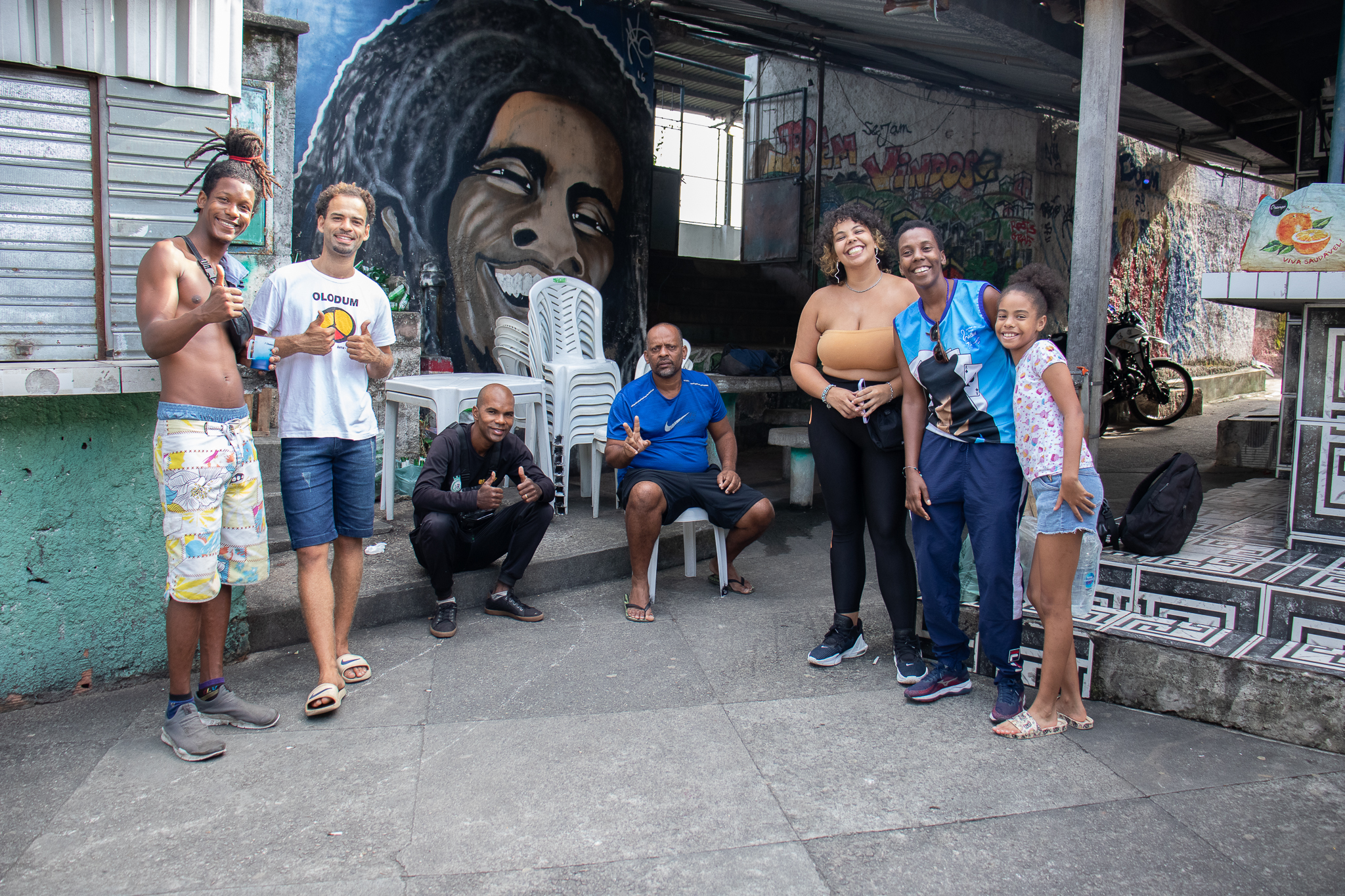
Tired of waiting for public action, a group of residents gathered on April 1, 2023, and organized a first collective action to revitalize the area. The “by us for us” action sought to make their favela climate resilient and improve the neighborhood’s living conditions. The group started the area’s transformation where the community was originally founded, Pedacinho do Céu, and, following the slogan “residents lend a hand,” set out for action.
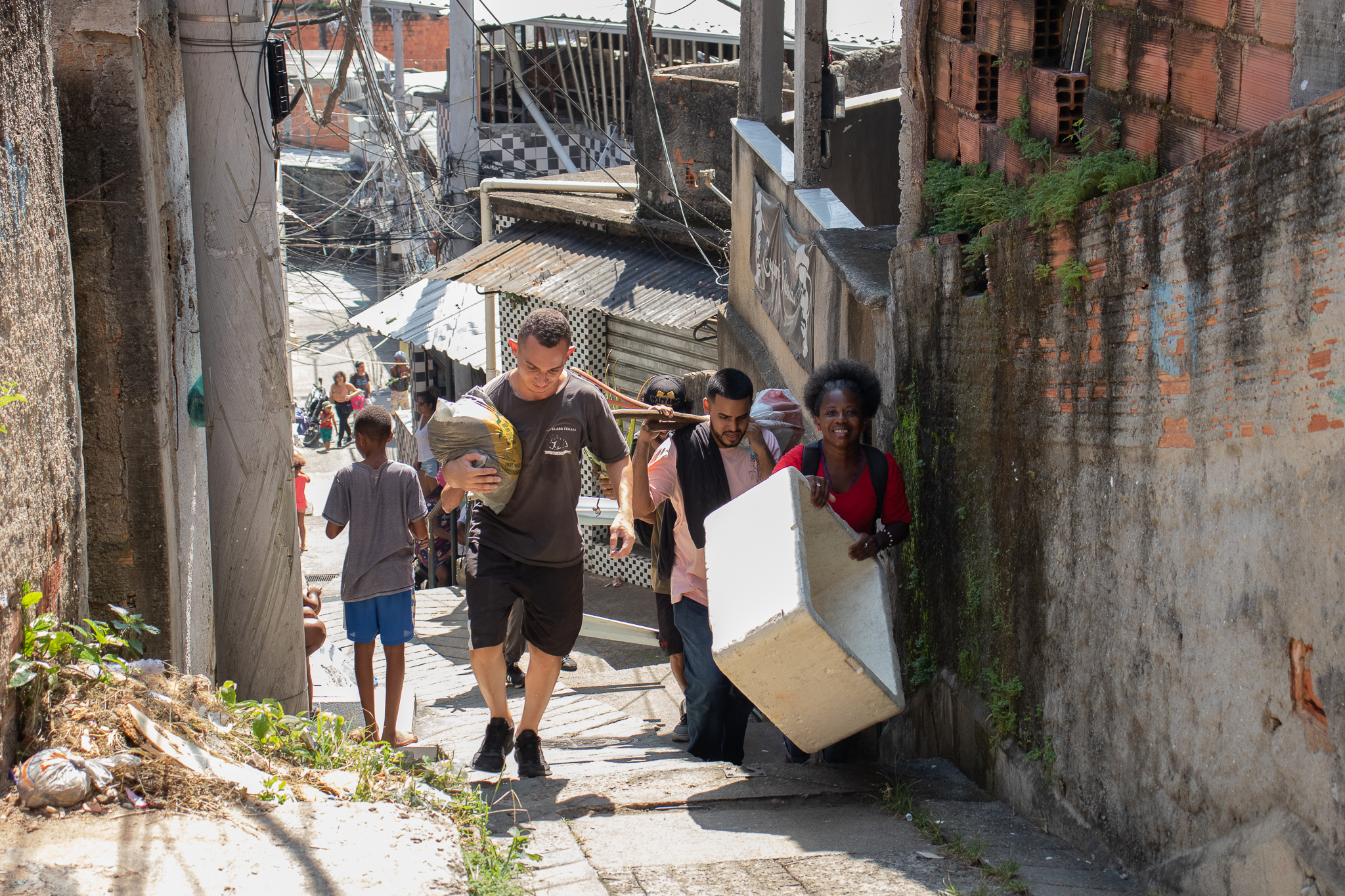
Priscila Alves, a filmmaker, photographer and musician, and Aluan Gomes, a historian and teacher, both born and raised in the community, planned the event and invited singer, composer, pagode musician and social activist Pipa Vieira to join in the action. For these three, who are now former residents of the favela, the place has a lot of ancestry, is filled with stories of struggles, and bears witness to the resistance of former residents in their fight for housing rights.
According to accounts from community elders, the first residents were exploited by land grabber Emilio Turano, an Italian immigrant who claimed ownwership of the land, despite not being its rightful owner. Illegally, he charged exorbitant fees from those who built their homes there. With the support of lawyers and counselors, they managed to expel him from the community in the mid-1930s and 1940s.
Alves, Gomes and Vieira have a strong connection with this place, marked from the beginning by its residents’ struggle. They say they are continuing the elders’ fight for security of tenure, ensuring that the area is not abandoned. The group intends to bring visibility, drawing the attention of residents from other parts of Turano and the government.
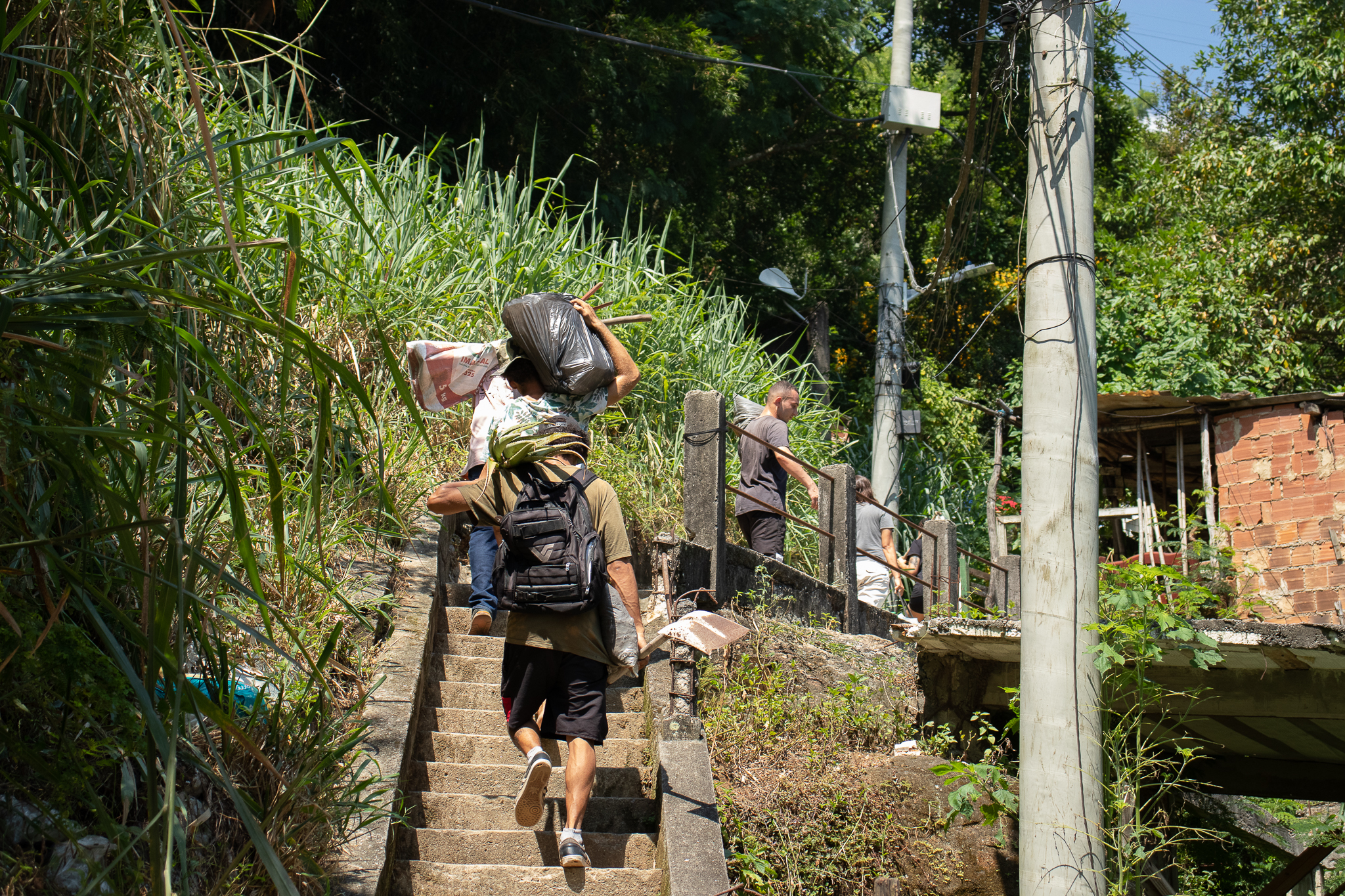
Alves recalls that it all started during a conversation she had with her mother about her grandmother’s vacant land in Pedacinho do Céu. She wanted to understand the current state of the area and if it was still possible to develop it. Her idea was to set up a meeting place for sharing ideas and fostering community culture and art. She sought out her cousin to get more information and made visits to Pedacinho do Céu to listen and exchange ideas with neighbors.
“My reference of collective actions comes from Zói, who lives in Raia—from the older generation that used to get together to help build each other’s homes, remodel each other’s homes. So, I said: ‘Let’s start the first environmental revitalization mutual aid group, with a whole vibe of a collective action, so everyone can connect. Long-time residents coming together to make things happen.’ I gave a lot of thought to putting together a group to renovate the old sports court in Pedacinho do Céu and to building a library. The whole idea is to encourage the community to start using the area again.” — Priscila Alves
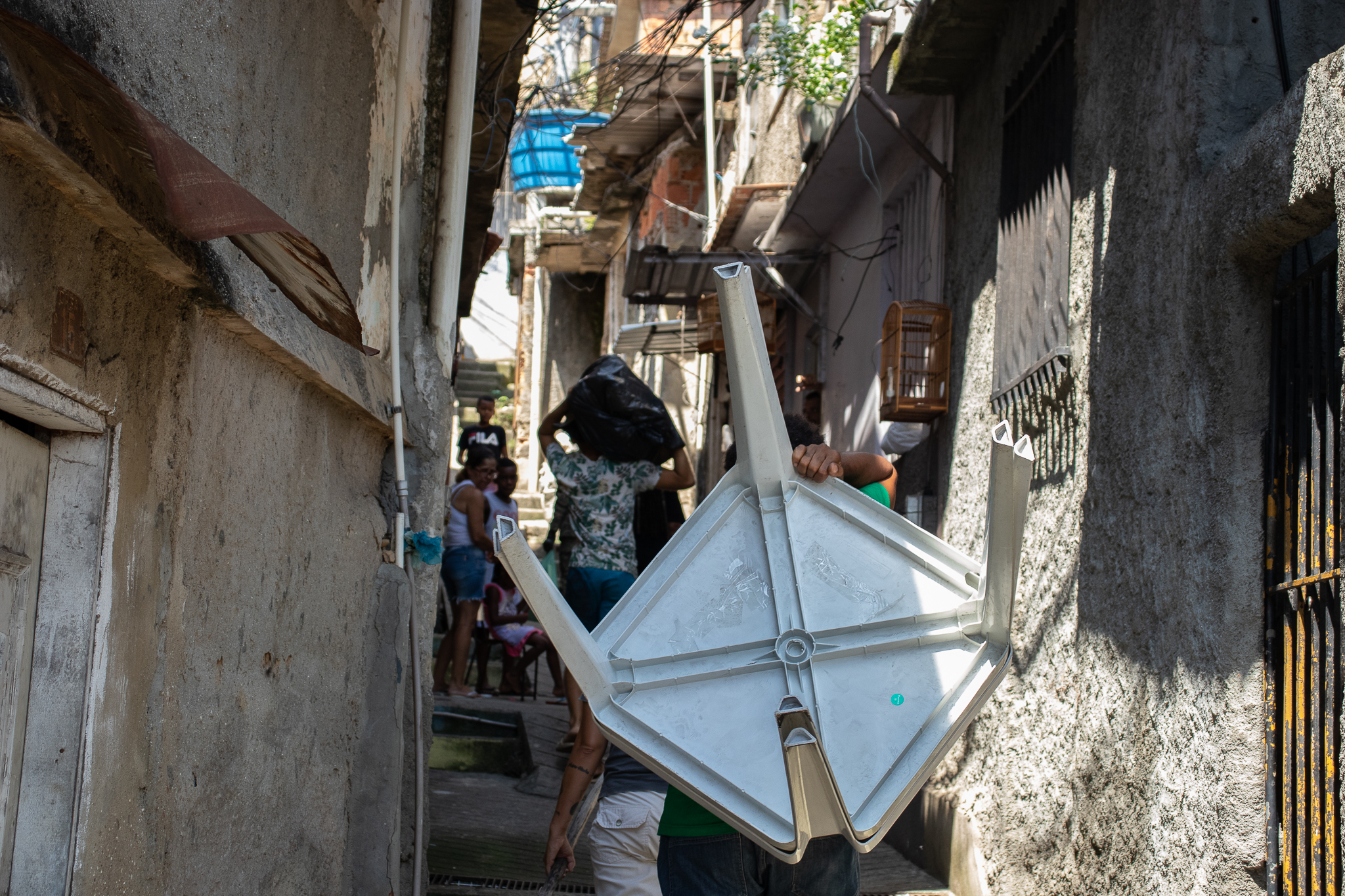
A Quick Stop to Rest and Reminisce
The first collective action to revitalize Pedacinho do Céu had the Raia sports court as a gathering spot, a traditional and well-known place in the community, located at the top of the favela, just below Pedacinho do Céu. The event began with a roundtable discussion and a breakfast offered by the organizers and participants.
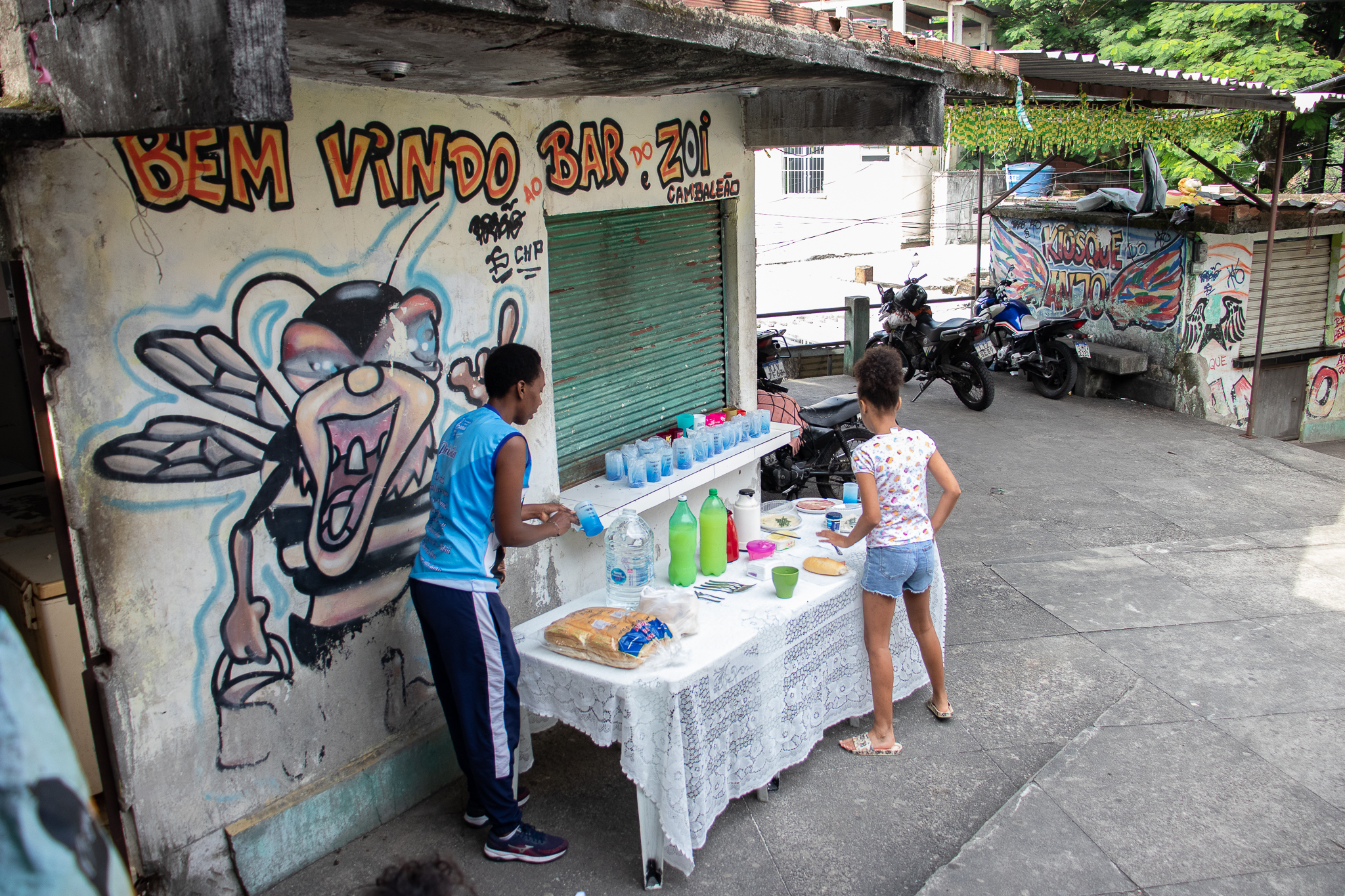
At the end of the meeting, everyone walked up the hill towards Pedacinho do Céu to begin the work. During the climb, residents introduced the area to outsiders, planning where they would start cleaning and where the site of Morro do Turano’s first community garden would be.
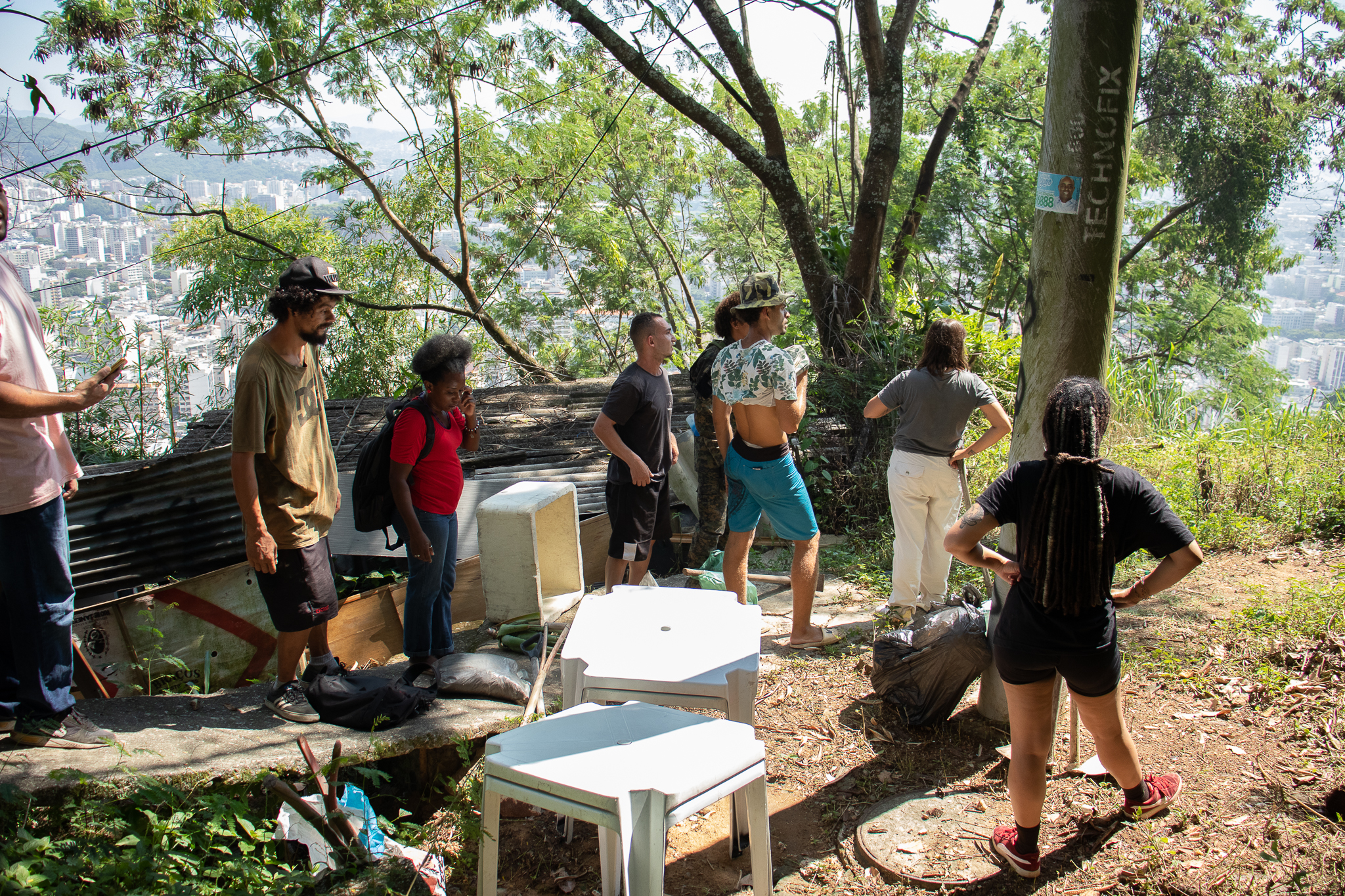
The place chosen to kickstart the revitalization was the local sports court, a spot filled with cherished memories of the past. Before starting the work, the residents began to reminisce about when the Pedacinho do Céu court was more frequently used by the community and the events that took place there. Two of these events were remembered with great affection and nostalgia. The “Arraiá da Tia Ana,” a traditional June festival organized in the 1980s and 1990s by a former resident, drew people from all corners of the favela and neighboring communities. Another memorable event remembered was the “Ball of the Roses,” held around the same time as the Arraiá da Tia Ana. The group recalled how crowded the party used to get, with gentlemen handing roses to the ladies they chose for a dance. The party took place on weekends and, according to residents, left behind fond memories.
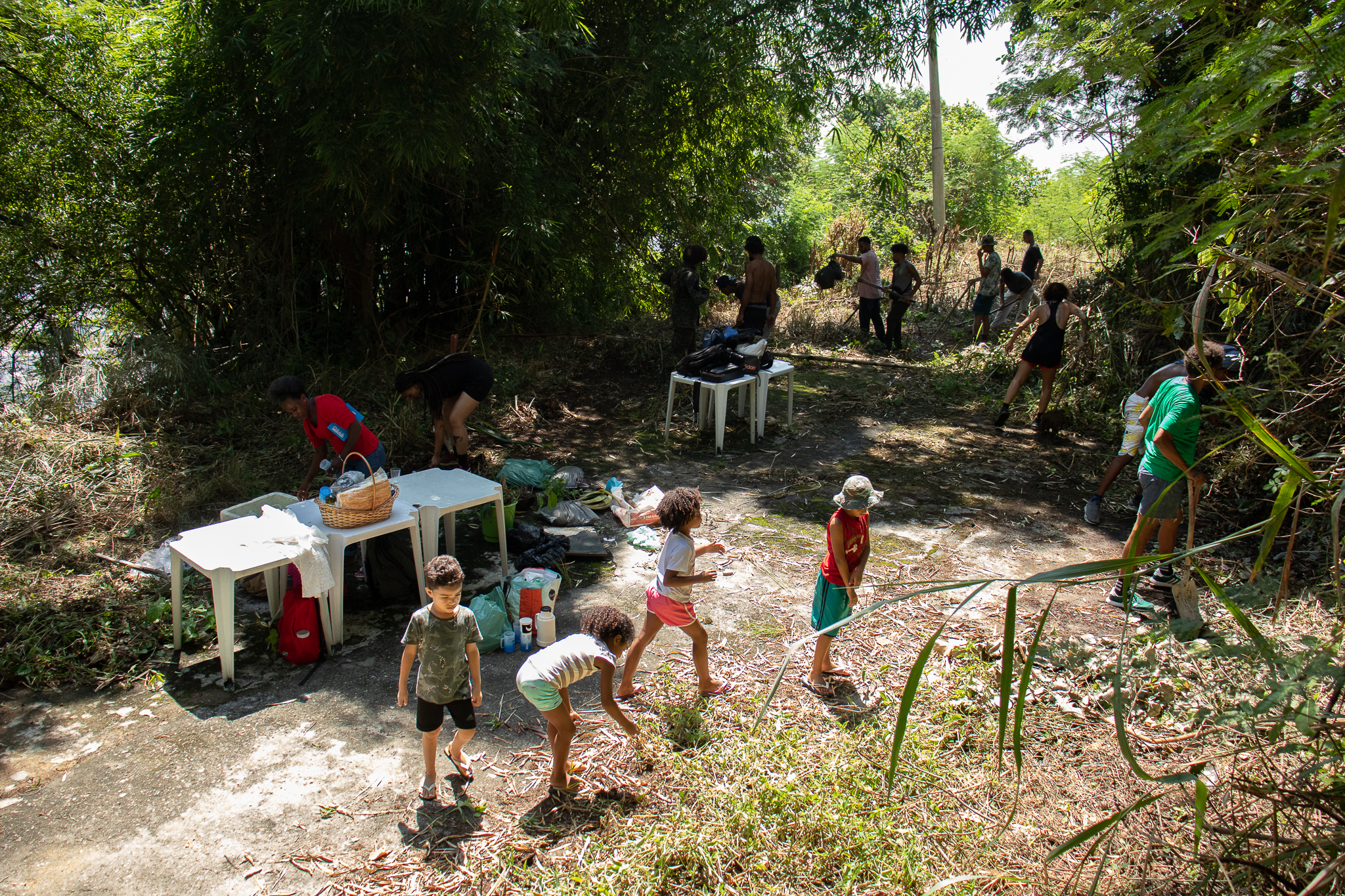
Residents also mentioned the soccer and dodgeball tournaments that took place on the court and were always packed with people. Many remembered a moment lived on the site and the games that are still memorable. These positive memories are what made the small court the site to kickstart the first revitalization collective action.
This moment of good memories and exchanges took place at one of the stops to rest from the climb. The trail from Raia to Pedacinho do Céu is a challenging uphill walk, with steep stairs, muddy paths and narrow stretches. Access is still very complicated. Up to a certain part, right at the beginning, it can be reached by motorcycle. The rest of the way can only be done on foot.
“My connection with Pedacinho do Céu is part of my musical training. My first musical references were the parties I enjoyed with my mother or some other guardian here… My family was from Salgueiro and I used to take this path to get there. I’d leave Salgueiro to get to Turano cutting through Pedacinho do Céu… I think it’s a sacred path.” — Pipa Vieira
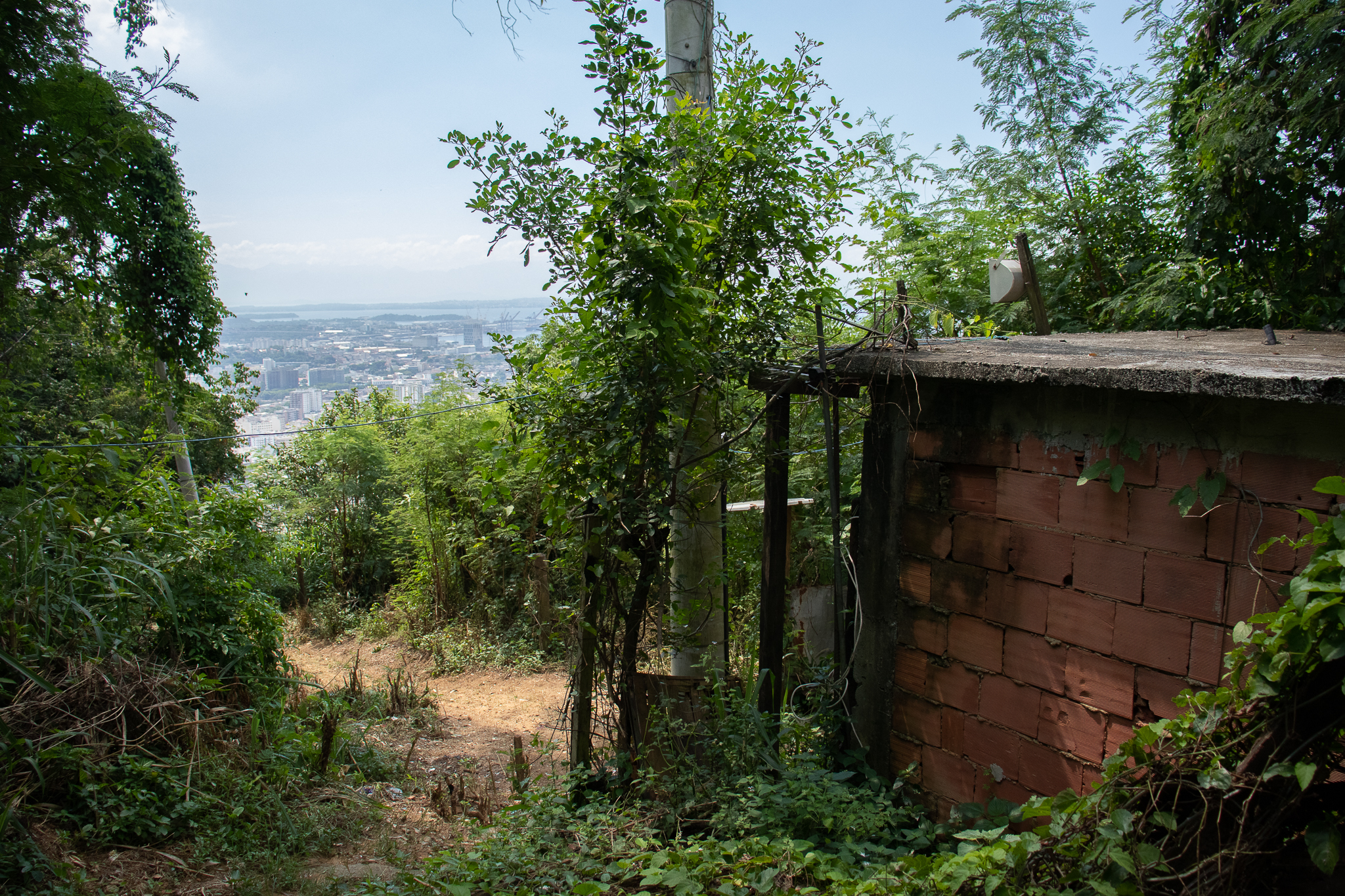
‘Long-time Residents Lend a Hand’
After the break and recollections, the crew prepared to get to work, sorting the seedlings and seeds that would be planted after cleaning the court and the space for the community garden. Days before, City employees had weeded out the space overgrown with bushes at the request of residents and the residents’ association. This helped the group’s efforts as they carried out the cleaning, removing garbage and overgrowth.
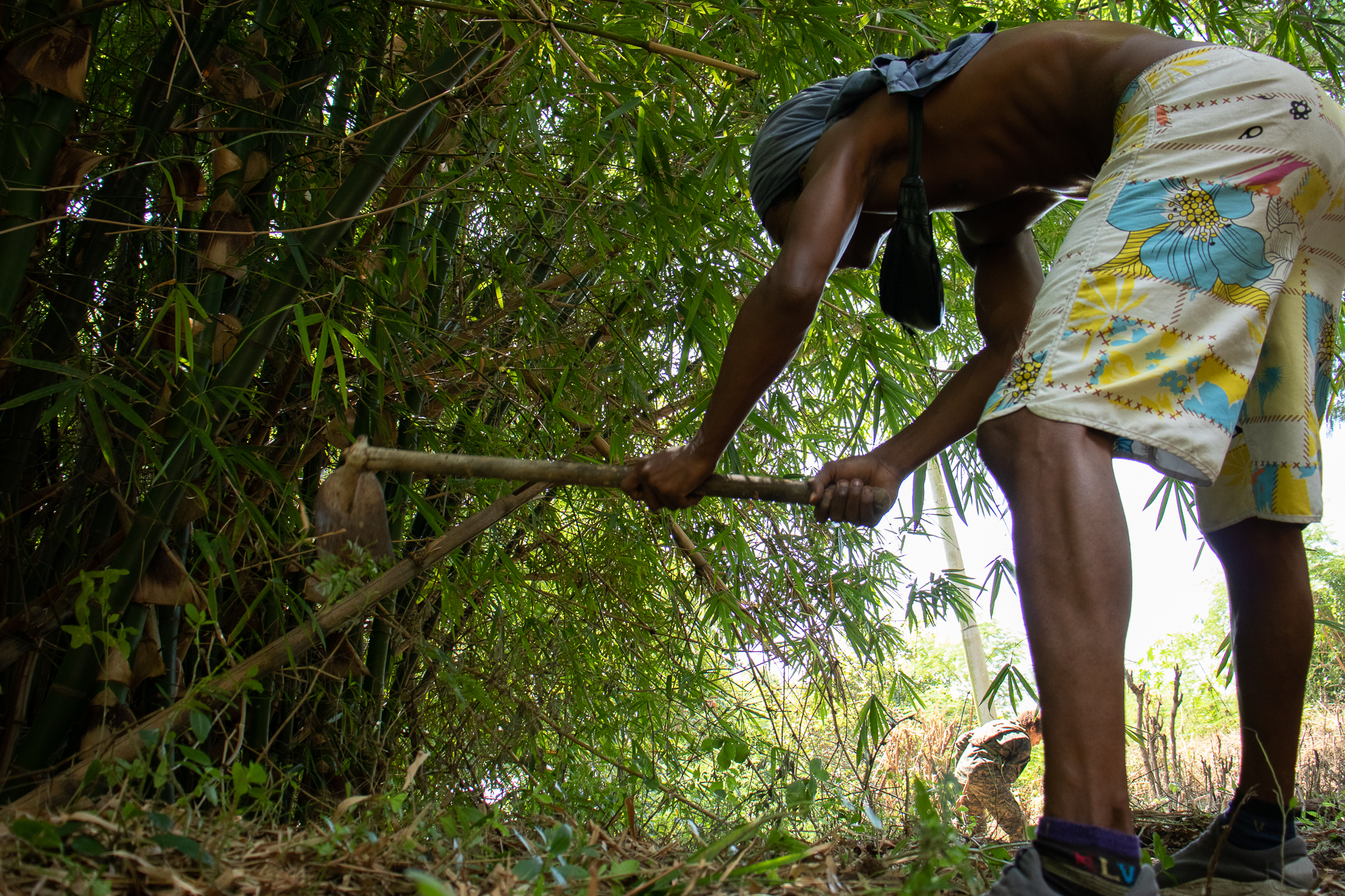
While some cleaned up the space, others sorted the seedlings and seeds to be planted. There was a focus on planting native species, so as not to damage the soil and interfere with local habitat. The group was also concerned about which seedlings to plant on the slopes to provide more stability on rainy days.
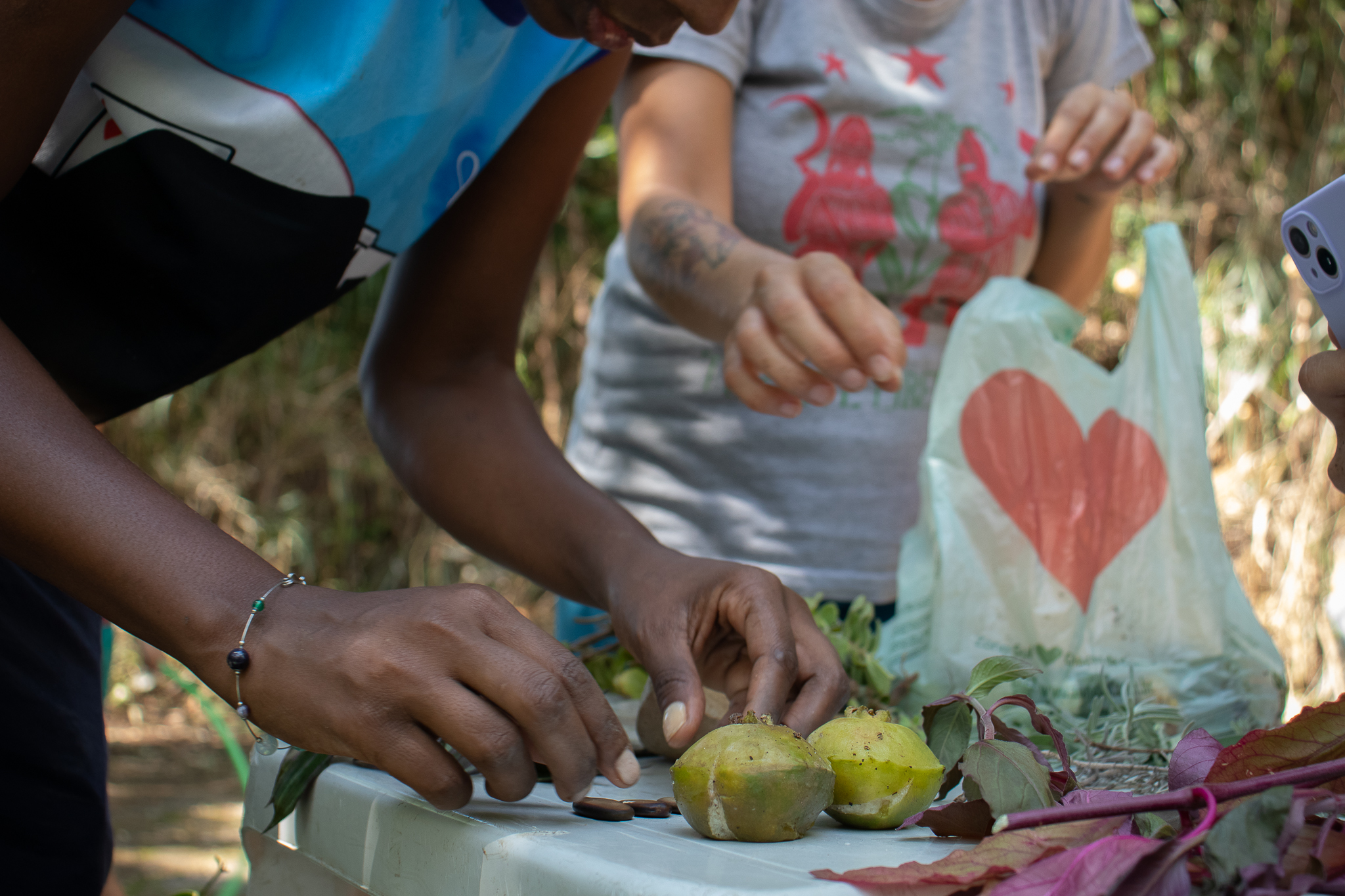
The proper disposal of garbage was yet another concern: disposal sites were signposted, promoting awareness among residents. As Gomes said, all these measures aimed at reclaiming Pedacinho do Céu, a place of historical and emotional importance for the Turano community, which was forgotten and abandoned due to State neglect.
“This revitalization is, in fact, a reclaiming of a space that is of great importance in the history of the favela. The place where our community originated was heavily attacked and vacated, many residents were evicted, and their houses destroyed. Many people here don’t know, and have never even been to Pedacinho do Céu. Some even believe it’s just overgrown with bushes and that no one lives here anymore, that it’s abandoned. The idea is to take it back and introduce it to all residents, especially the younger ones and children… so they can get acquainted with and once again occupy this space.” — Aluan Gomes
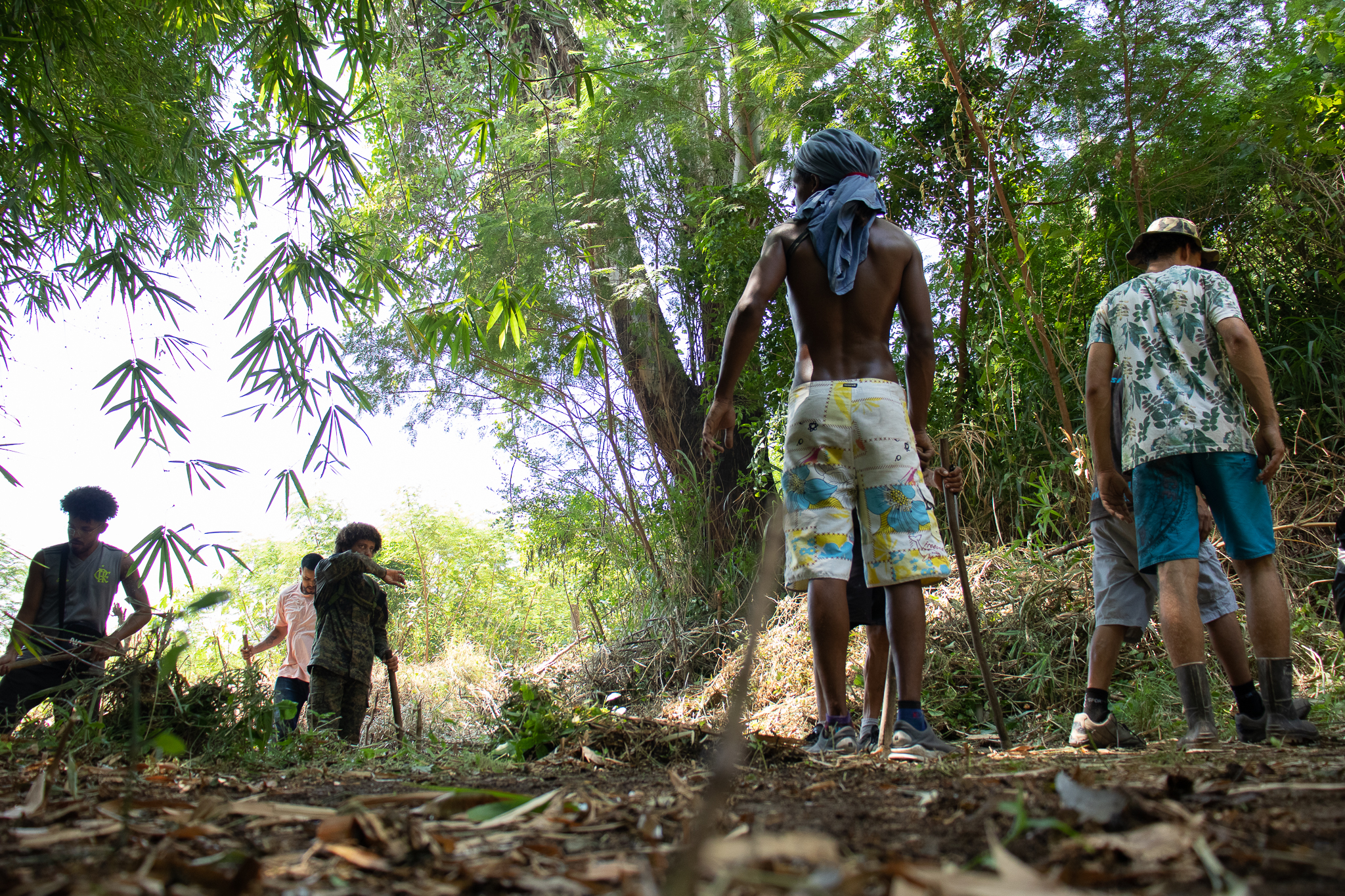
For the start of revitalization, herbs such as basil, mint, rosemary, aloe vera, Chilean boldo, common boldo, and terramycin were planted. Trees such as banana, lemon, orange, guava, Surinam cherry, and acerola were also planted; the idea is to cultivate various fruit-bearing trees.
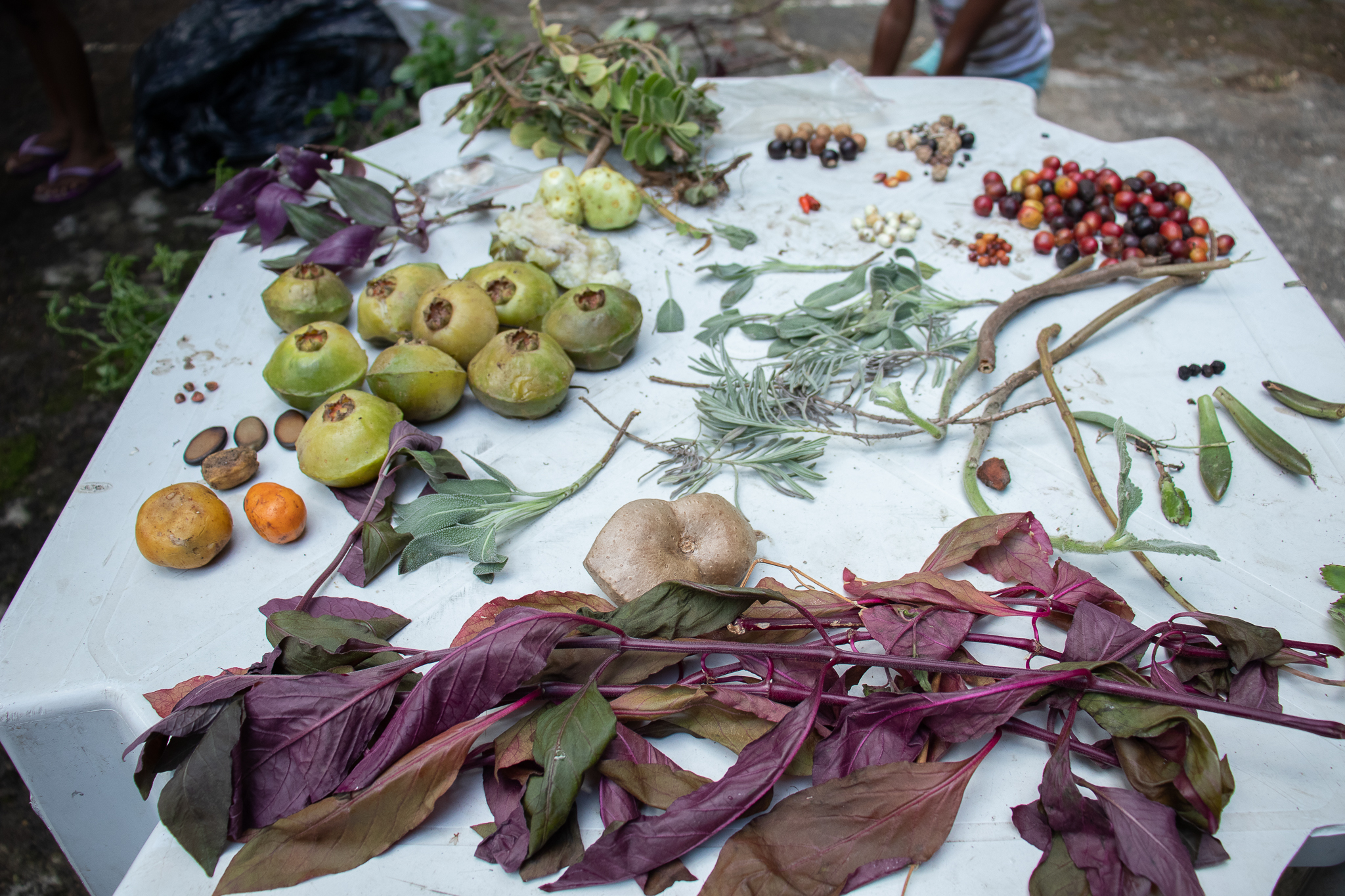
A participant of the group, Bianca Ortiz, took several seeds, seedlings and fruits, to be planted on the site. Ortiz gave an explanation on each seed, seedling and fruit, providing details about the planting process and the benefits of each. One of the seeds she took was coffee, no longer found in the area, despite the region’s past as a vast coffee plantation. Açaí seeds were also among Ortiz’s contributions.
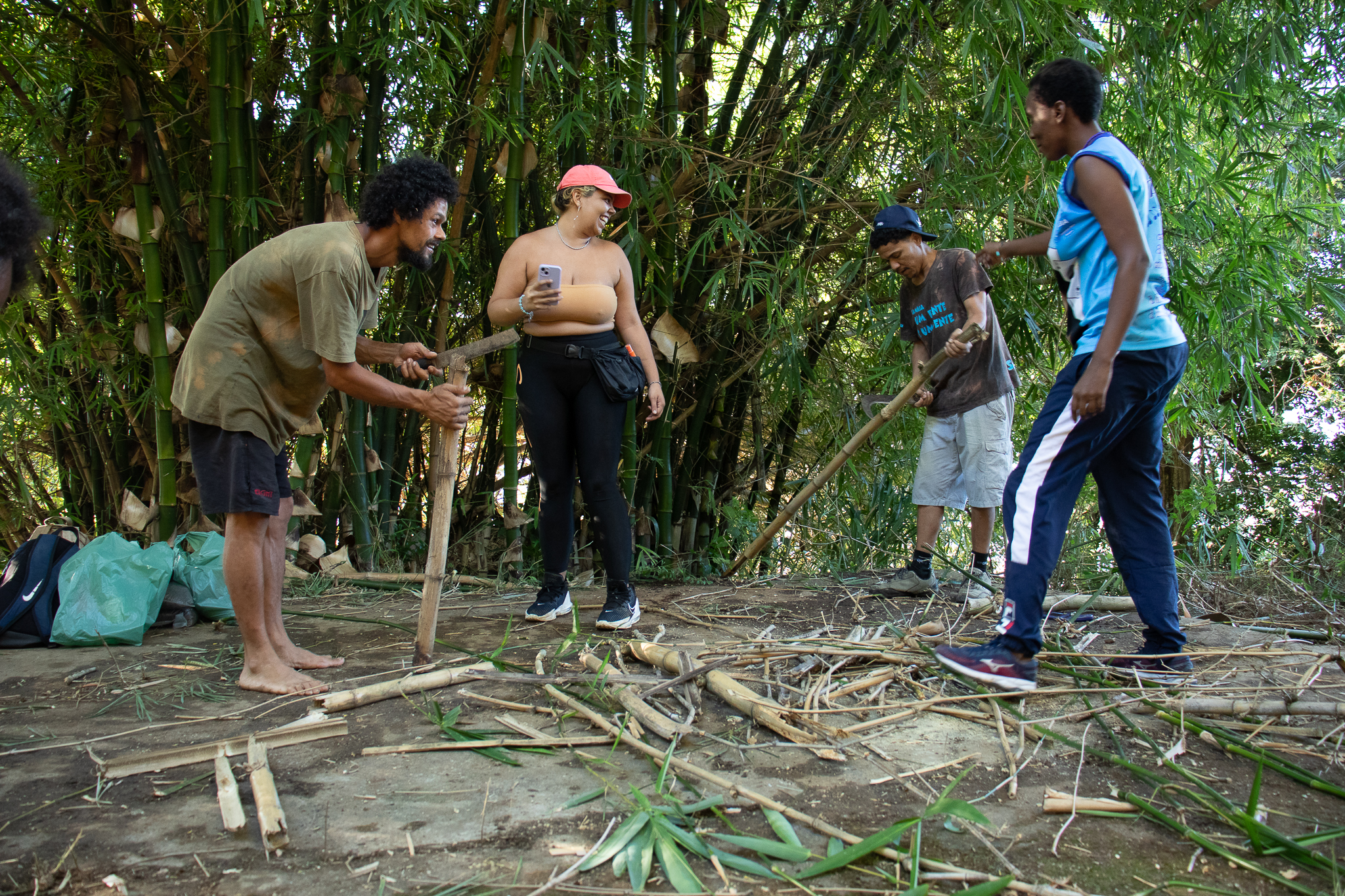
Ortiz also brought fruit such as noni, which typically grows in Asia, cambuci, native to the Atlantic Forest, and pitaya, usually found in Central America and Mexico. She also brought yacon potato seeds, which originate from the Andes, and are known in Brazil, as “the diabetic’s potato.”
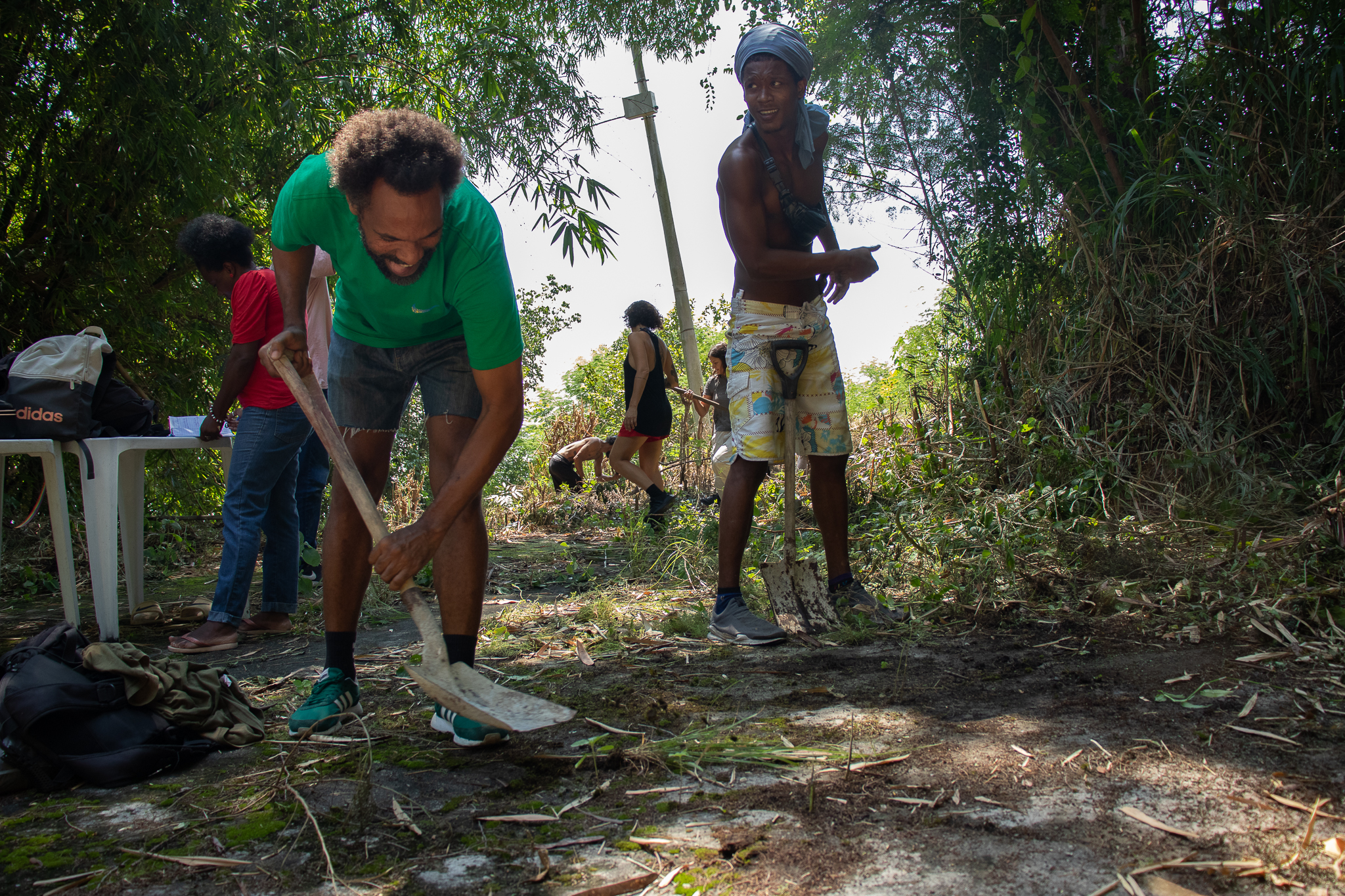
One garden was set up in the traditional way and the other in a spiral, taking into account the herbs’ and vegetables’ need for sunlight and shade.
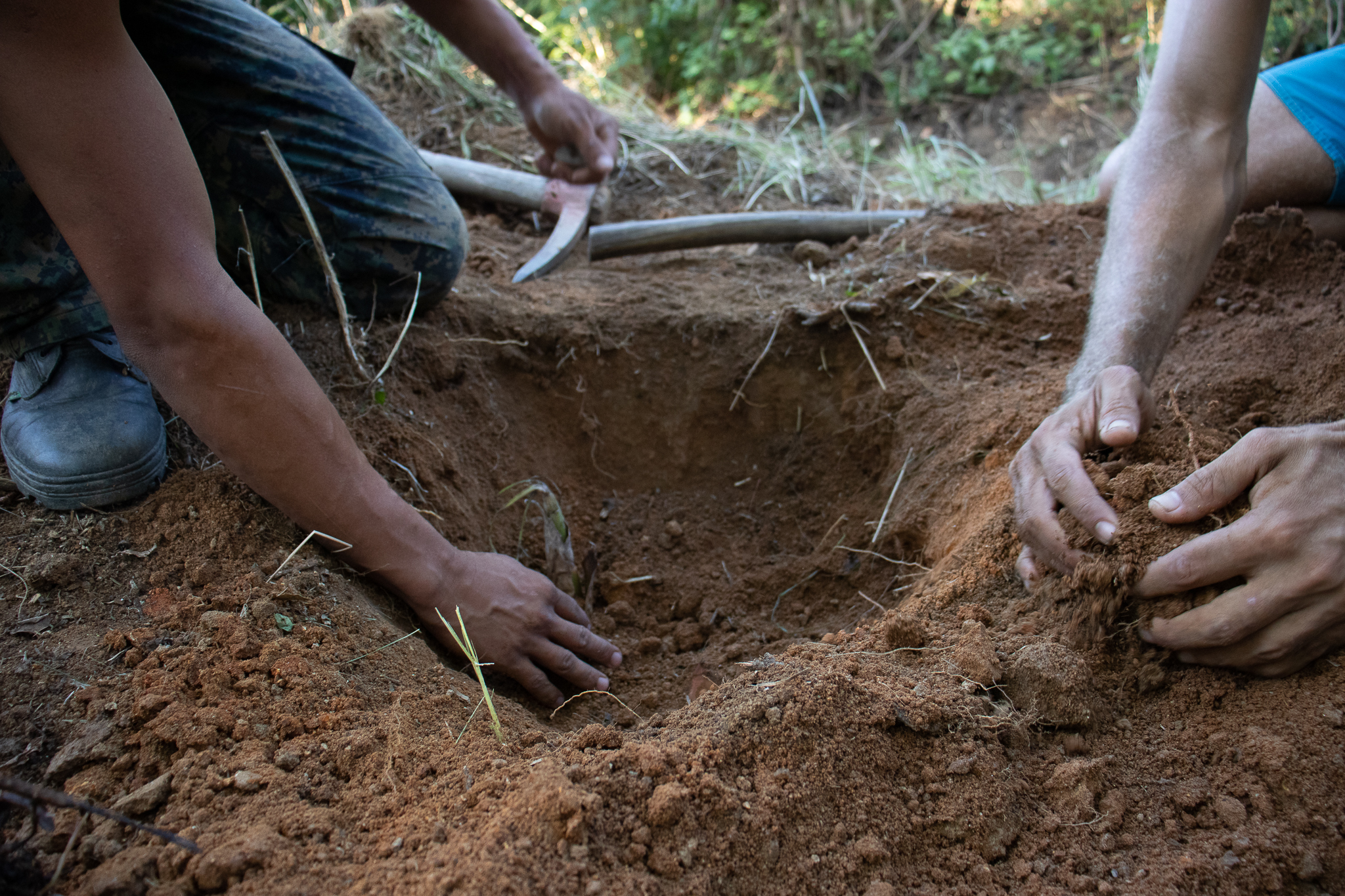
One of the striking aspects of this first collective action was the presence of children. They saw everything as a big game and, in doing so, made significant contributions. Very curious, they asked questions and paid close attention to everything, including the explanations and teachings provided by older participants. After all, the legacy will be passed on to them for future continuity.
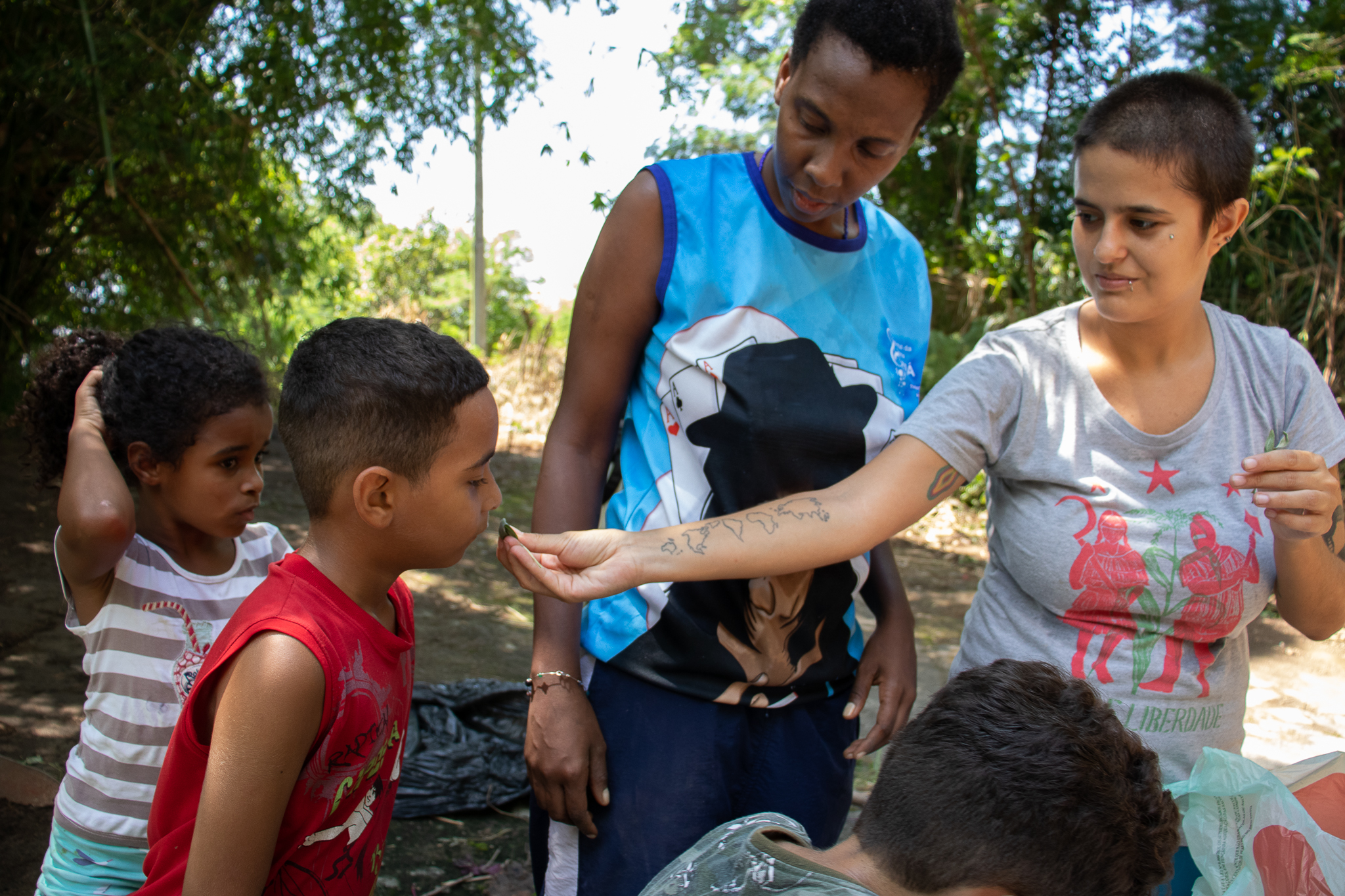
With the work well underway, the crew took a break for lunch. The meal was prepared by Beto, who lives in Raia. Dona Elza, a resident of Pedacinho do Céu, shared her terrace for everyone to gather and eat. Lunch was a moment of relaxation, with ideas exchanged, more stories shared, and appreciation of the view of Tijuca, Central Rio and Guanabara Bay.
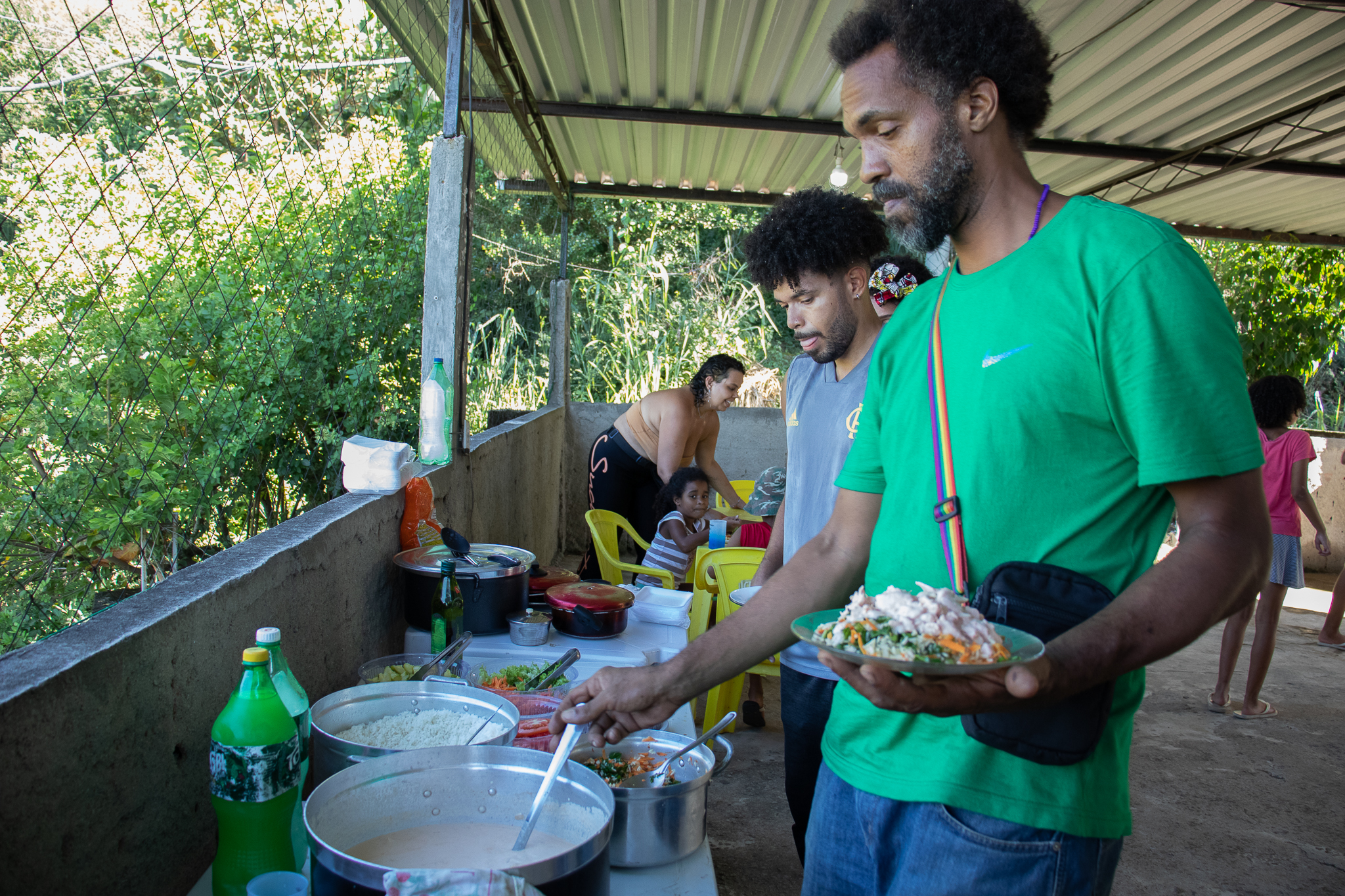
Turano Residents Speak Up
In 2010, according to the Brazilian Institute for Geography and Statistics (IBGE), 10,000 people lived in Morro do Turano. However, according to data from the Ministry of Health’s Family Health Program, this number has exceeded 13,000 inhabitants since 2013. According to residents, there were about 450 families living in Pedacinho do Céu alone. Following the tragedy of the 2010 rainstorms, however, which caused a major landslide involving earth, rocks and some houses, this number decreased considerably.
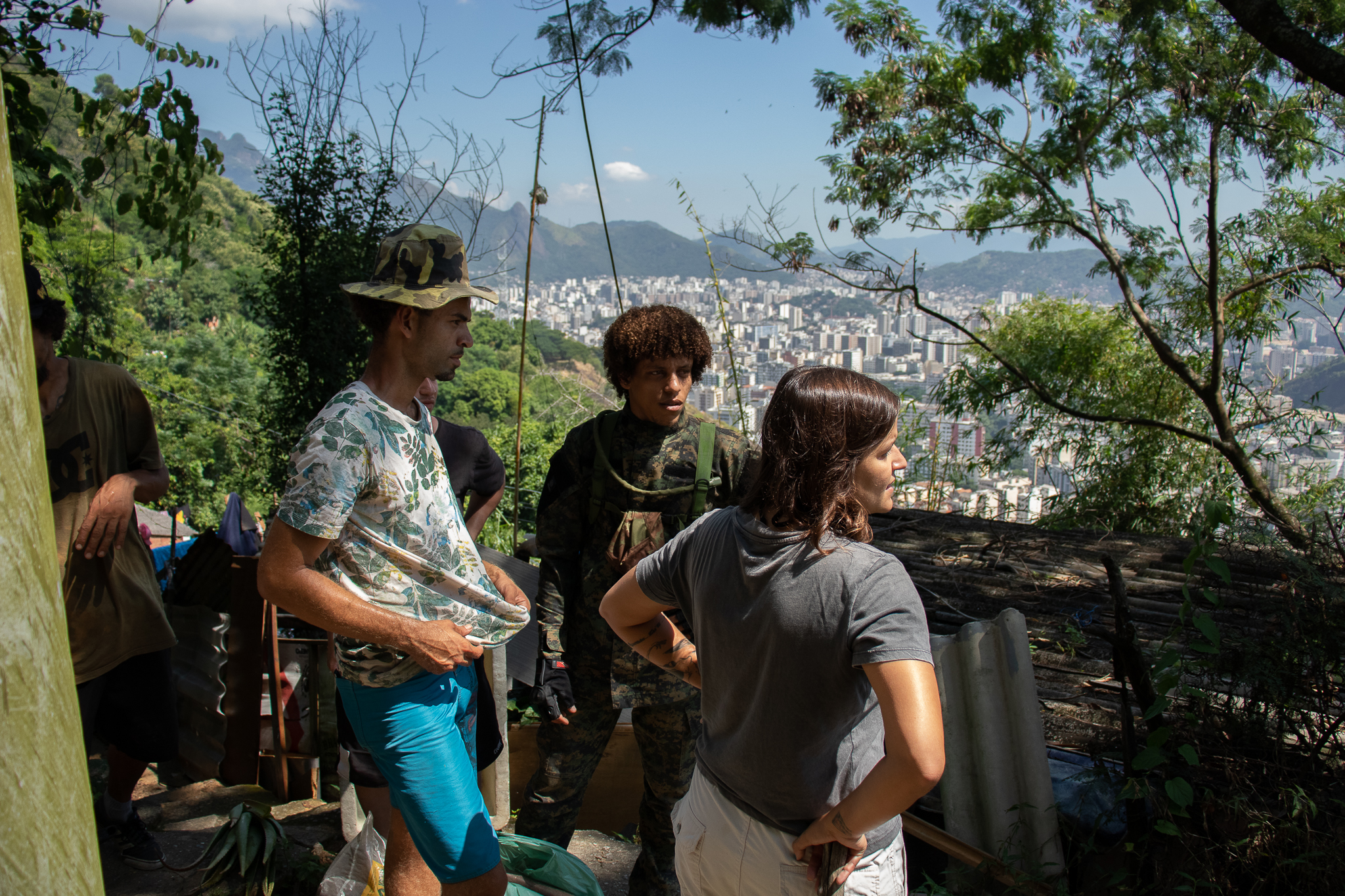
Many homes were removed by City Hall after authorities declared it a “risk area.” In addition, out of fear, many residents left after the tragedy, leaving the area almost vacant. Today, very few families live there; according to residents, currently only some 30 to 40 remain.
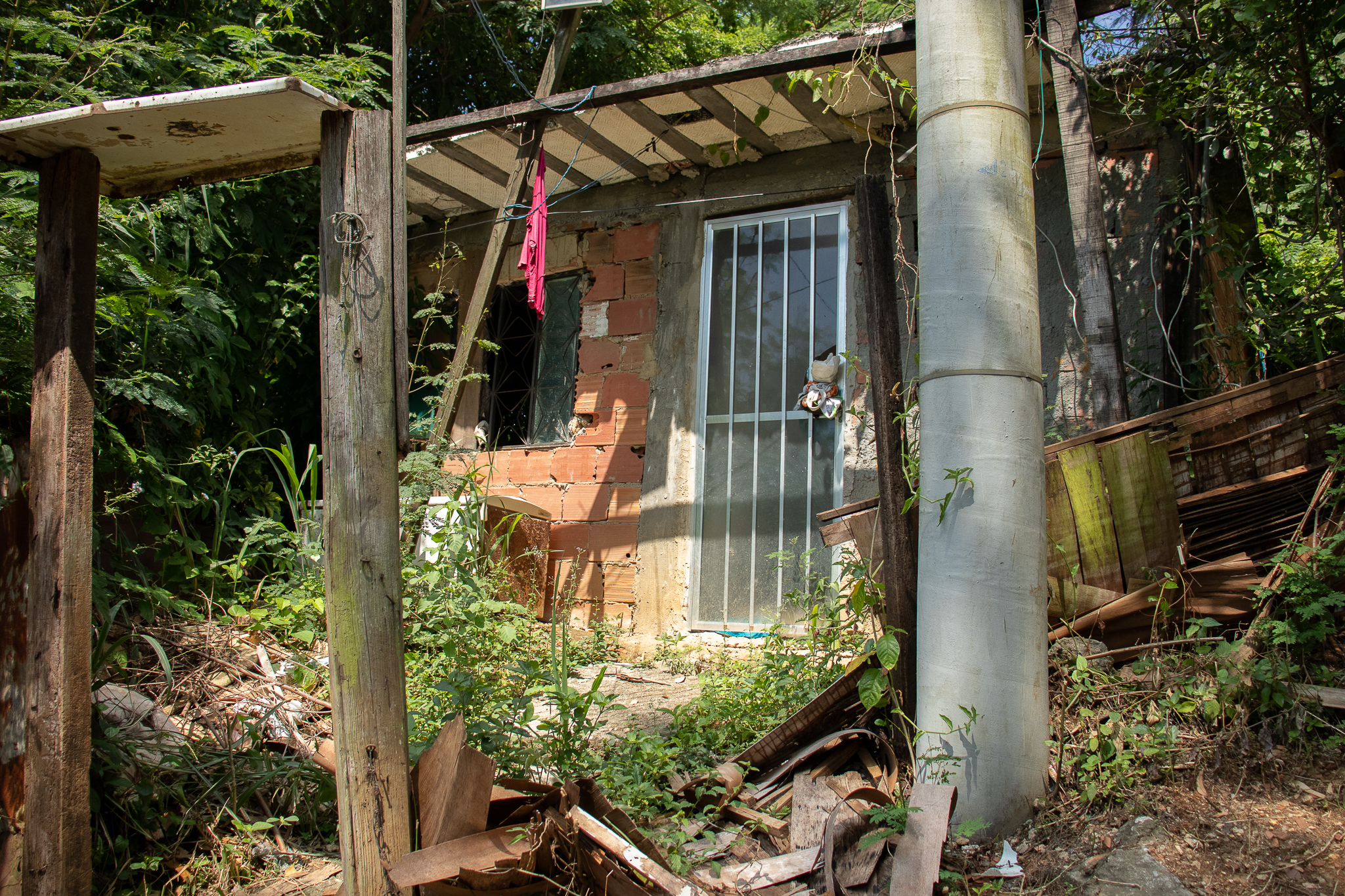
One of the few people still living in Pedacinho do Céu is Elza Martins, known as Dona Elza. She moved to the area at a very young age in the 1960s, with her parents and siblings. She regrets that there is nothing left in the place and describes it as completely forgotten, saying that many people think it is overtaken with bushes and garbage, and that some municipal authorities mistakenly identify it as Matinha, which is, in fact, another area of Complexo do Turano. Dona Elza points out that Pedacinho do Céu lacks proper garbage collection, because the few community garbage collectors do not go up to this point. Garbage is disposed of on slopes, ravines or vacant lots. Another sign of this abandonment, according to her, is that, until very recently, there wasn’t even a Community Health Agent appointed to assist them. They only started having one after a resident went to work at the Family Clinic.
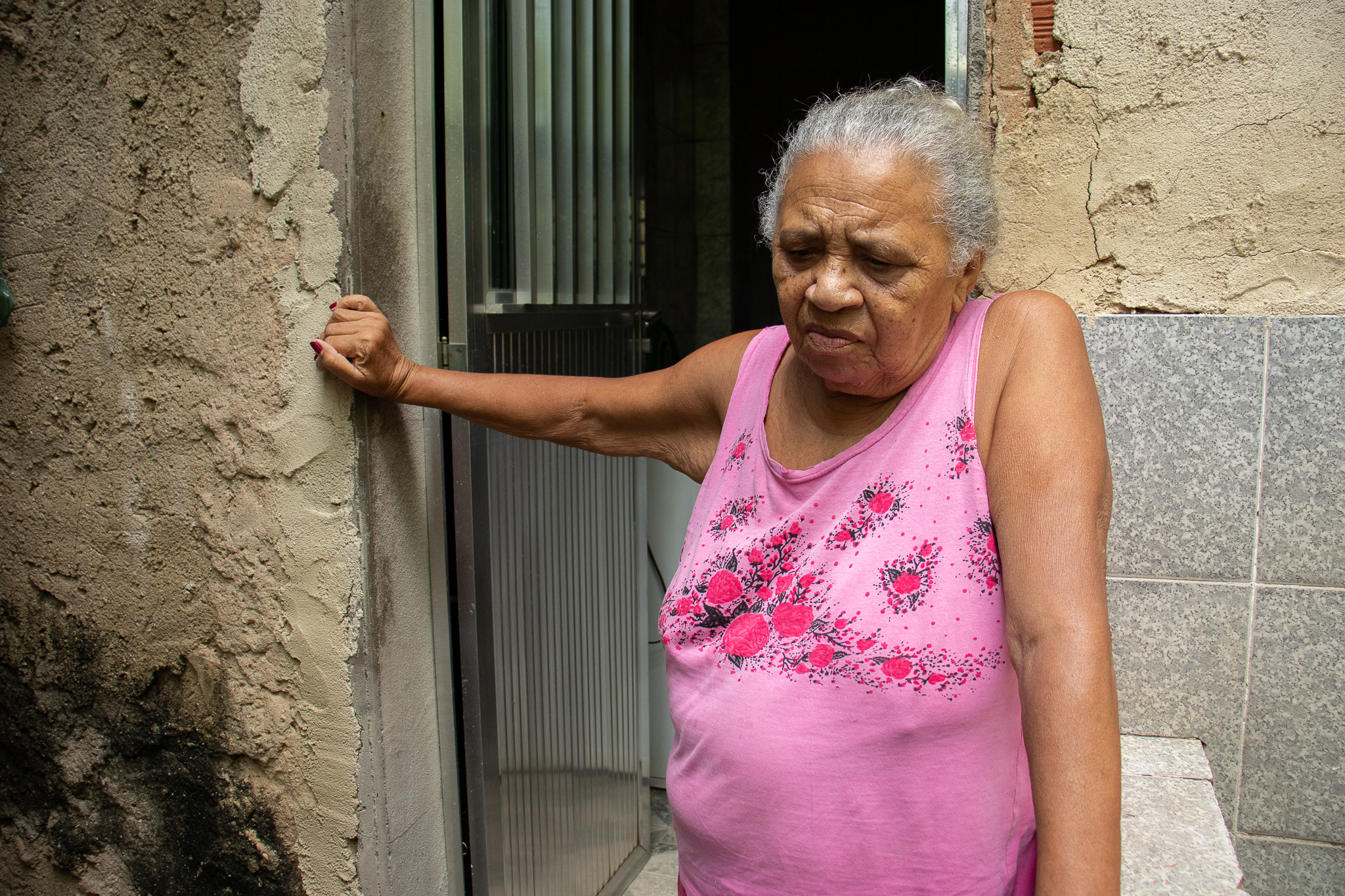
“I think things will get much better. It will be as if the place was coming back to life… we feel forgotten and left behind here. It’s a good thing they turned on the electricity a short time ago… For those who ride a motorcycle, you can ride up until down there. Now, when it comes to a proper road, I don’t think that’s going to happen. It would be great if we had a road here, even just up to the field.” — Dona Elza
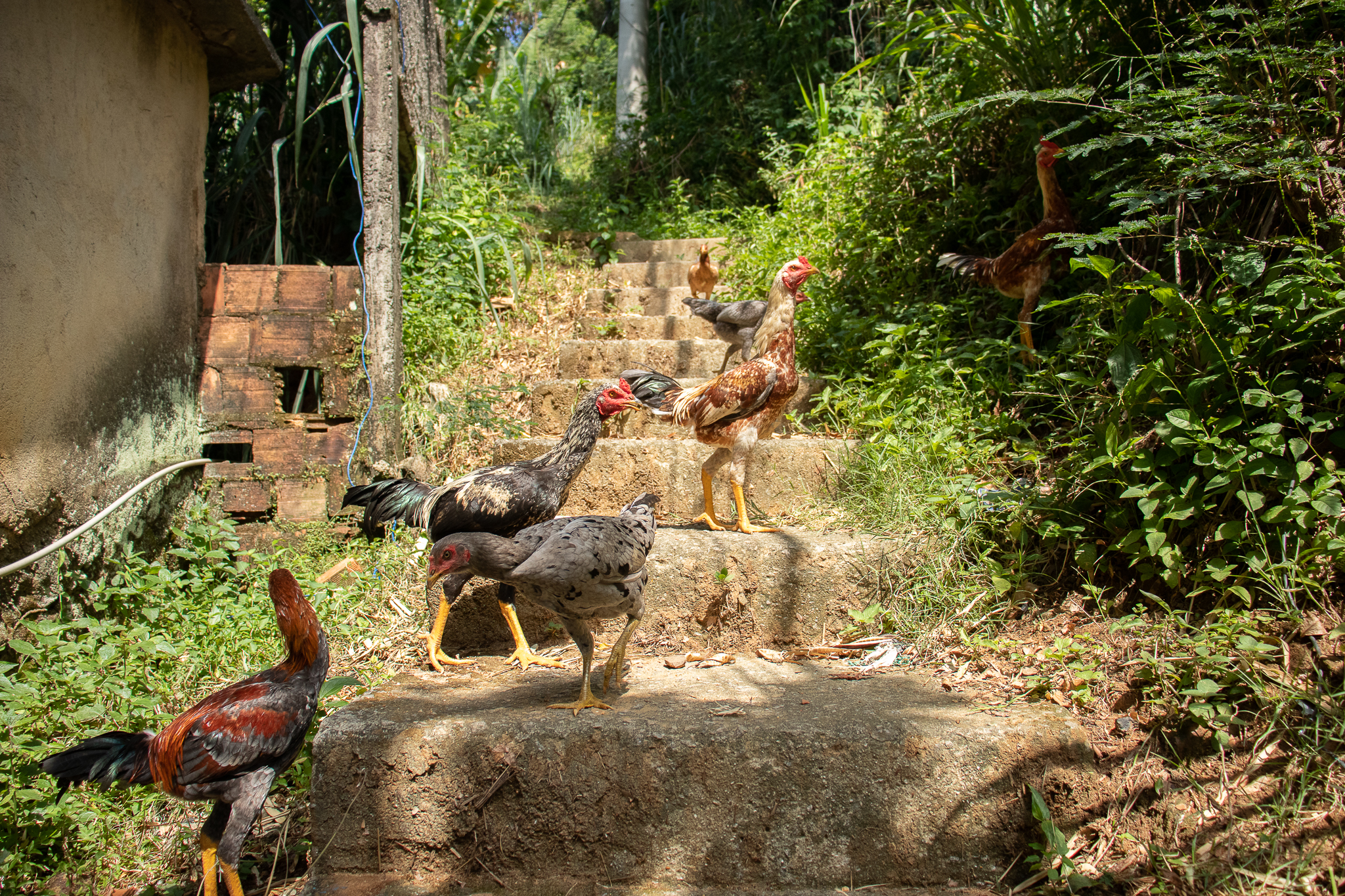
After chatting with Dona Elza, we continued downhill and stopped at the home of Marco Antônio Silva. Known as Marquinho, he was born and raised in Pedacinho do Céu where he has lived for 52 years. Marquinho shared that in 2019, after losing his two children, he rented out his house and went to live in São Gonçalo. Unable to adapt to his new home, he returned to Turano after six months, this time settling in Bacana, another area of the favela. He also spent six months there, and then returned to Pedacinho do Céu, from where he no longer intends to leave.
According to Marquinho, the downside of the area is not having better transportation, because motorbikes, the only vehicles that can go up the hill, can only make it so far. This, he says, is not enough because if someone gets sick or needs help, there is no way to reach them.
In addition, he also mentions that, for a long time, residents had many problems with the lack of water because the only water tank they had supplying the homes was built many years pior by Friar Cassiano. It received water from a spring at the top of the hill. With the population growth in Turano, this water source became insufficient. When the Favela-Bairro program returned to the community for the second time, another water tank was built to expand the supply. However, many homes were still left without water. At this point, residents took the initiative to drill the newly installed water pipes that ran in front of their doors to improvise water connections to their homes and for their neighbors, guaranteeing this universal basic right.
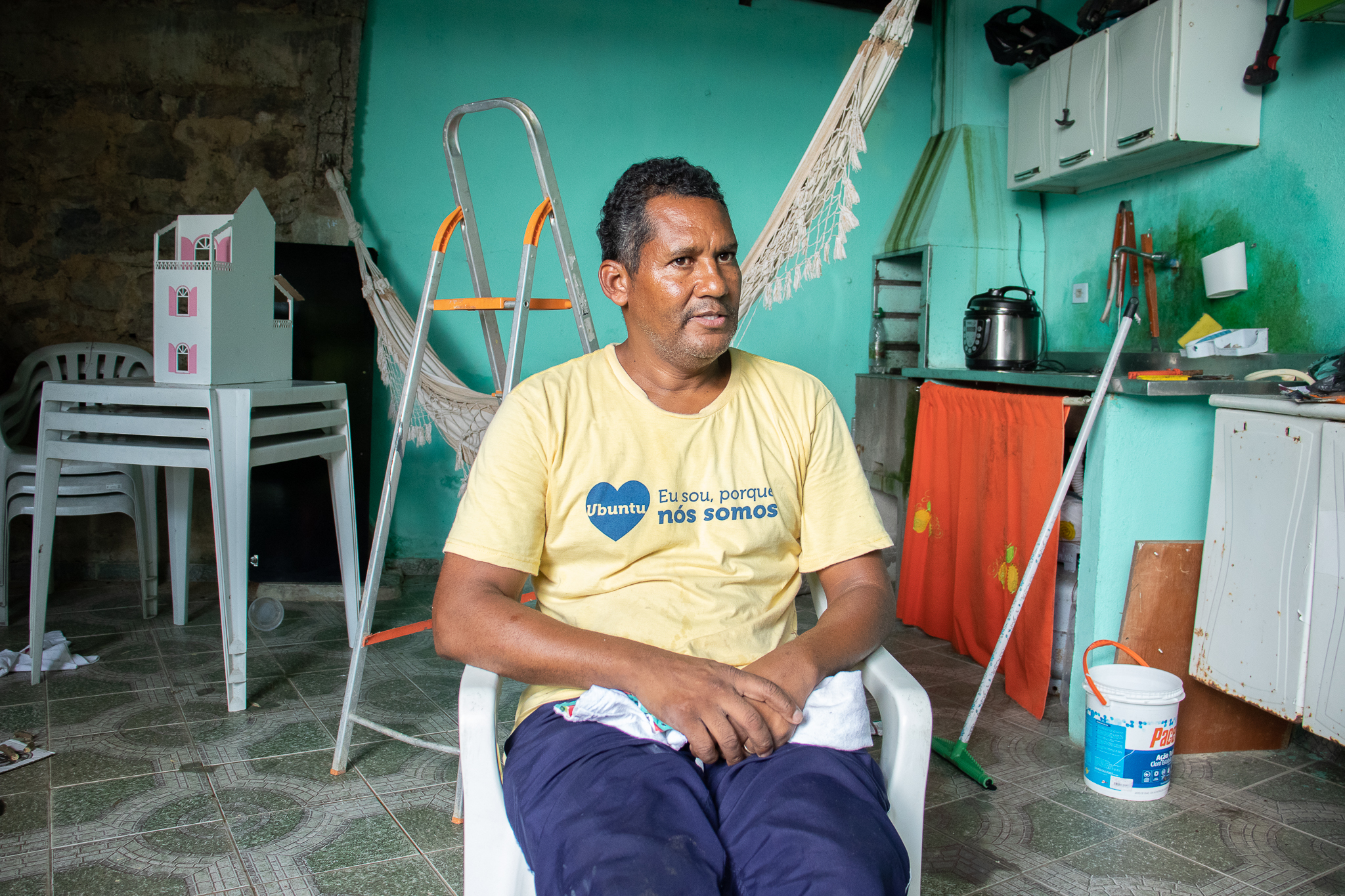
“Back in the day, we used to get a group together to bring construction materials up here… When I moved away and then came back… the kids that I once saw so little… even the heavy stuff, they carried and brought here… It’s all pretty much uphill, from Campo do Bacana here, but when I looked, they’d already taken all the furniture. The whole kitchen was already set up when I arrived. They brought up the fridge, the stove, the gas cylinder, everything, you know? It was those kids that I saw when they were so little, now all grown up, who helped me… But it’s because I’ve always been a family man, always one to join in and lend a hand… For the June festivals, I’d cut bamboo. I’ve always helped out, because I’ve always supported my community.
When the whole deal happened in 2010 [the rain tragedy], my wife didn’t want to stay here. I already had this whole structure in place… so, I called an engineer over… I told him that my wife didn’t want to come home and asked if there was any risk of us staying here. I asked him to take a look around my house. I had already made this stone wall because, up here, there really was a risk of a landslide. Since I had built the wall, he assured us there was no risk of a landslide hitting my house. This retaining wall was built by me, my cousin, and another young man who lived up here, not by City Hall.” — Marquinho
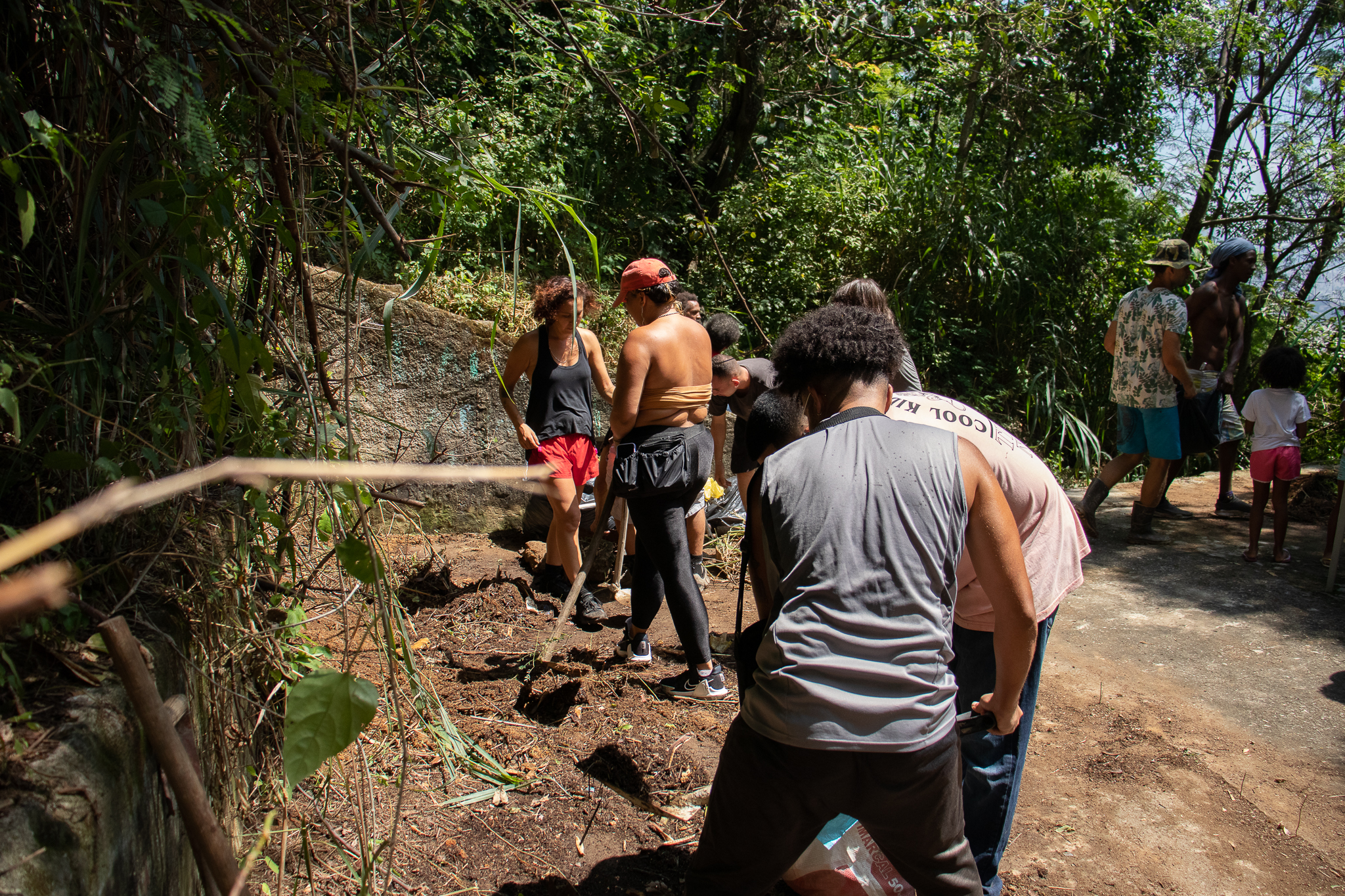
The aspiration of Pedacinho do Céu’s residents is to come out of oblivion. And that’s what Priscila Alves accomplished when she organized friends and former neighbors to revitalize the place where her grandmother once lived. Her goal was to bring back the cultural and sporting events of the past, to revive the tradition of planting and harvesting, and to reforest the hillsides, thereby preventing further landslides.
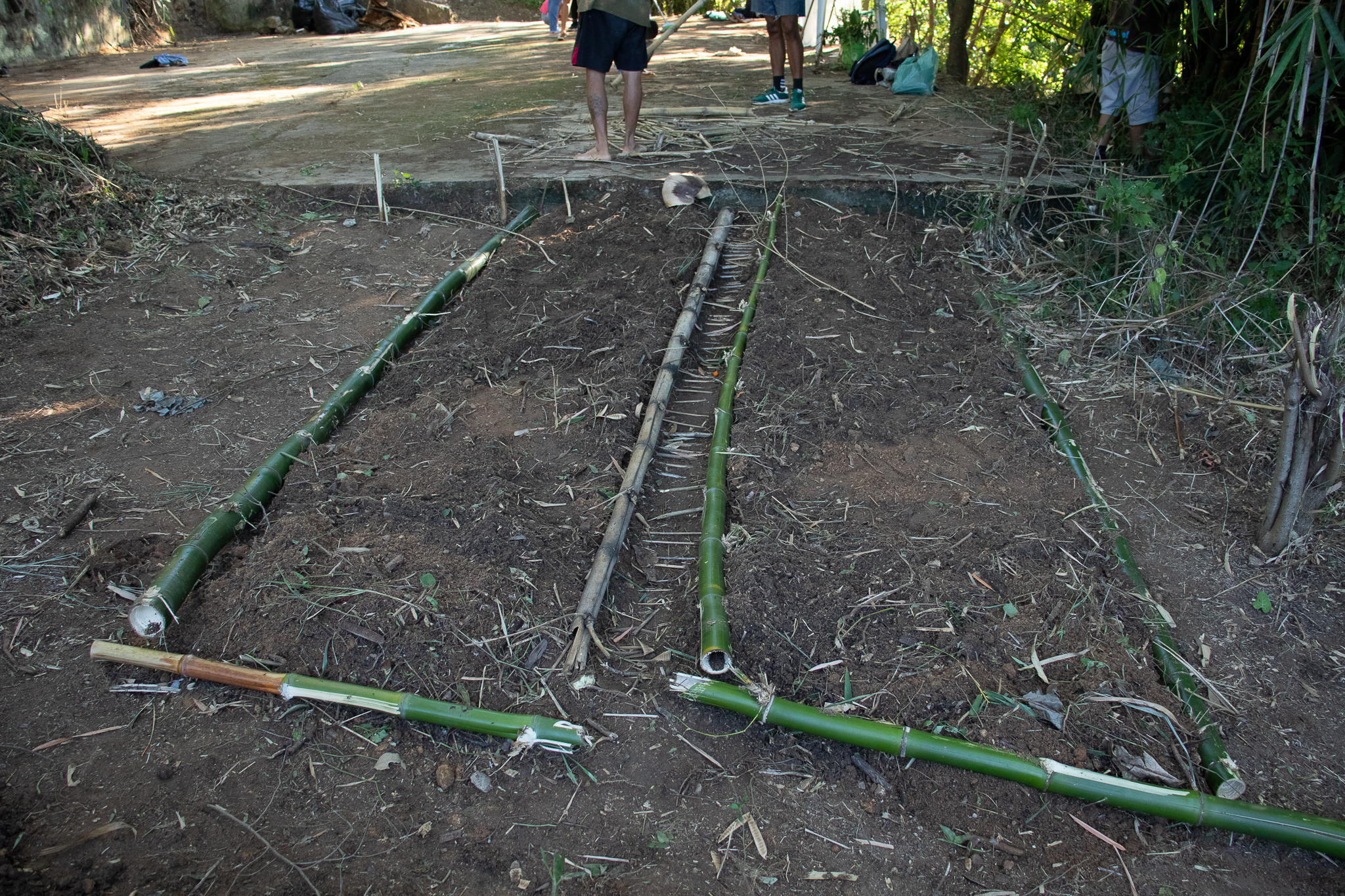
Aluan Gomes, on the other hand, is determined to preserve the history of the place that gave rise to Complexo do Turano but, for some reason, was lost and fell into oblivion. Pedacinho do Céu is very close to the residence of the Archbishop of the Catholic Church of Rio de Janeiro, Orani Tempesta, referred to by the residents as the “Home of the Priests,” in Sumaré. The high clergy of Rio’s Catholic Church sits just one road away from Pedacinho do Céu, in the palace that hosts the Pope when he comes to Rio.
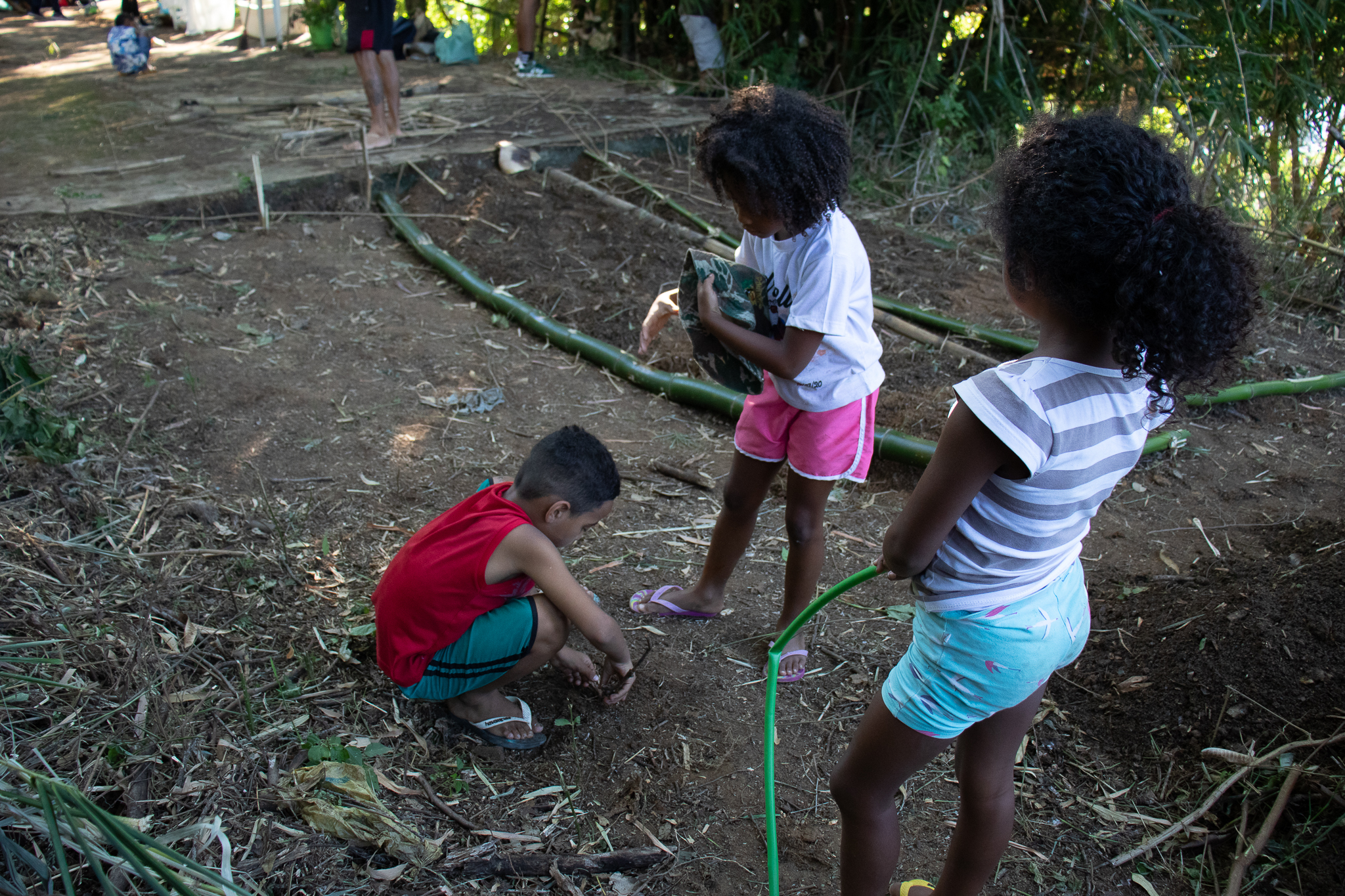
Pipa Vieira envisions the possibility of teaching percussion to children and teenagers on the court. The singer won a bid from City Hall to develop the project in a location of his choice. For him, it holds enormous potential and many budding percussionists may emerge from there. But the main intention of all the participants of the revitalization group is to rescue Pedacinho do Céu from abandonment, attract more residents from other areas of Complexo do Turano to join in and, why not, expand the Pedacinho do Céu collective action to the whole favela.
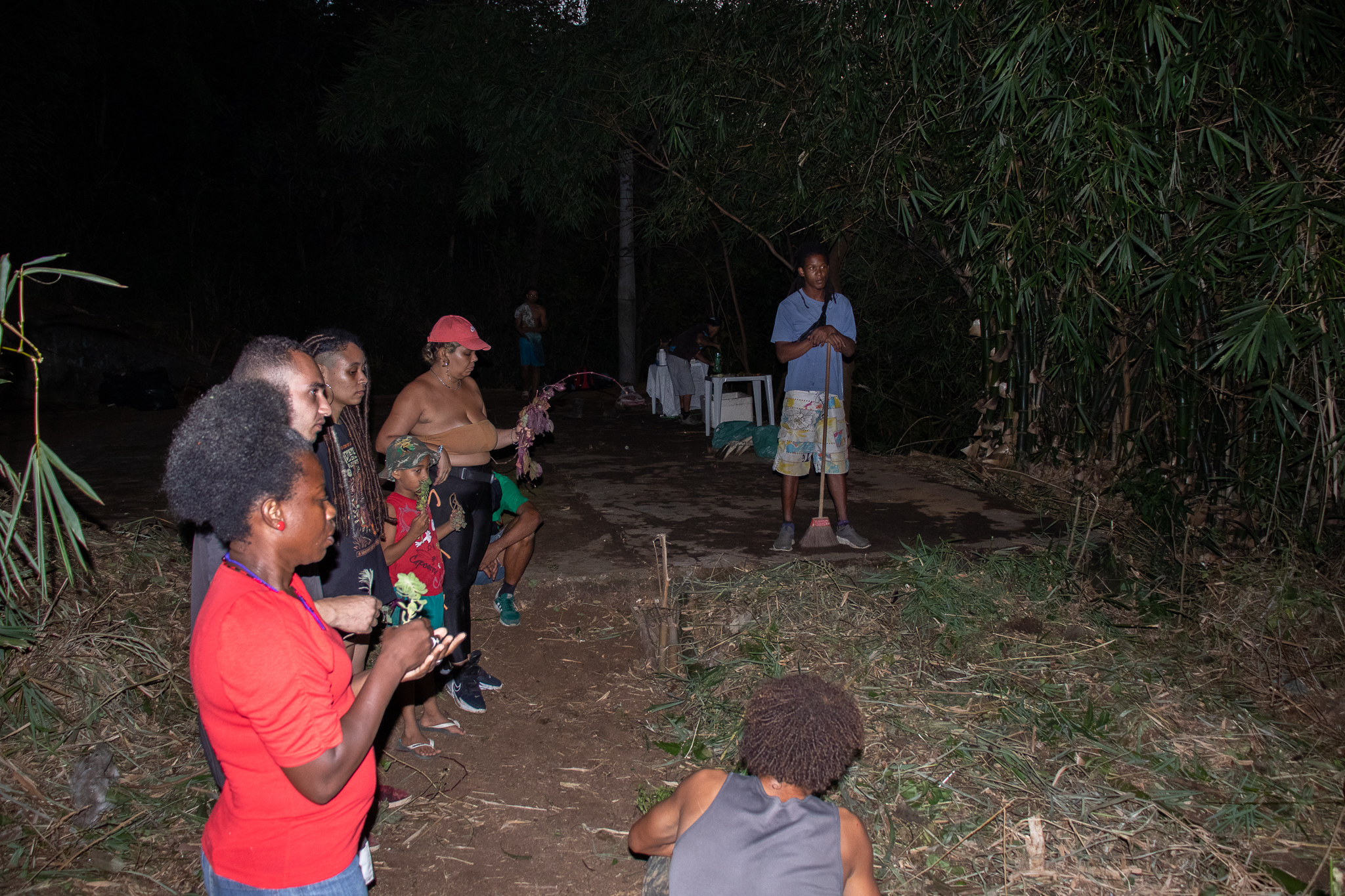
About the author: Carla Regina Aguiar dos Santos was born and raised in Morro do Turano. Her work as a community journalist has always prioritized the day-to-day happenings in the favelas. Reporting what goes on beyond the view of traditional media, she has contributed to the Favela News Agency (ANF), A Pública, Eu, Rio! and Terra. She received the ANF Award for journalism in the culture category and the Neuza Maria Award for Journalism.

